Choose your language
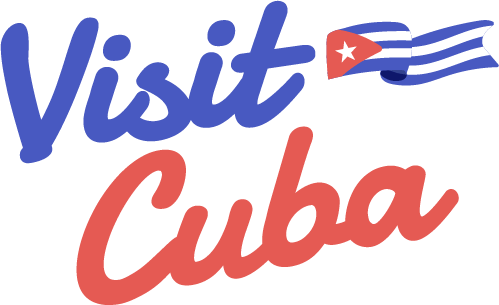

Welcome to Cuba
More than you imagined
Plan your holiday to Cuba
Cuba Up-Close
Six Essential Tips for Your Trip to Cuba 2022
From alternative accommodation to bypassing the restrictive internet in Cuba, check out these six essential tips for your trip to Cuba.
Cuba up-close
When is the best time to visit Cuba?
Planning a visit to Cuba? The island offers sunny skies and activities year-round. Learn more about its seasons, weather, and cultural calendar.
Is it safe to travel to Cuba?
Here are some of the best safety tips to follow as you enjoy your trip, and use public transportation in Cuba.
Greatest Waterfalls in Cuba
Imagine finding yourself in Cuba, surrounded by an exuberant natural environment - where the vivacious green mountains stretch out into a splendid blue sky - while the fresh Caribbean seabreeze brightens your face. And on this tropical voyage, you discover a land of waterfalls on every corner of the island.
El Nicho waterfall, Sierra de Escambray
Photo: Shutterstock
Looking for some cool things to do?
Lesser known parts of cuba to discover this year.
Escape the crowds and Look further into the Cuban landscape
Sip and Dance Your Way Through Trinidad’s Nightlife
Things To DoSip and Dance Your Way Through Trinidad's Nightlife
City Guide: Cienfuegos
Cienfuegos is a picturesque coastal town with laid back charm
Five Cuban Clothing Brands to Shop for in Havana
Take a look at the emerging Cuban dress wear brands
La Casa del Ché: The Home of Ché Guevara
Discover Ché Guevara's life & legacy at Casa del Ché
Visit Chinatown in Havana
Visit the only Chinatown in Cuba, right in Central Havana,
Best Spots for Fishing Around Cuba
Largely untouched and diverse, Cuba is one of the most
Cuba’s Top Destinations For Your Next Mountain Bike Adventure
Get to know the 5 best spots for mountain biking
Six Cool Things to Do in Trinidad, Cuba
From colonial architecture to vibrant rumba beats, uncover the top
Fábrica de Arte Cubano: A Unique Experience for Art Lovers
Havana houses one of Time Magazine’s Best 100 experiences: the
Top Four Jazz Clubs in Havana
Cuba’s capital has always enjoyed a lively jazz scene, and has produced legendary musicians. It’s time to visit Havana’s best jazz clubs!
La Zorra Y El Cuervo jazz club, Vedado, Havana
Photo: Alamy
Winter activities and tips!
History & Heritage
Visit the Museo de la Revolución
Wildlife & Nature
Ciénaga de Zapata
Castillo del Morro
Beaches & Islands
Hit the Beach at Tarará
Tarará Beach – Havana’s Best Kept Secret
Tired of typical tourist spots? Get to know Tarará beach,
Castillo del Morro: A Historical Fortress in Havana
Learn about the History of Cuba in the bay of
Ciénaga de Zapata: A Natural Cuban Treasure
Encounter the endemic flora and fauna of Matanzas Cuba, and
Visit the Museo de la Revolución, and Relive the Fight for Cuba
Havana’s Museo de la Revolución offers a thorough look at
The Cuban Cigar: Everything You’ll need to know
Learn about the curious and mysterious history of the Cuban cigar, how a Habano is made, and where you can buy quality tobacco like Cohiba cigars.
A Cuban woman with a cigar, Havana
Check Us out on Instagram
@govisitcuba, subscribe to our newsletter.
Get more travel inspiration, tips and exclusive offers sent straight to your inbox
I would like to get Visit Cuba newsletters in my inbox
Paradise for Your Inbox
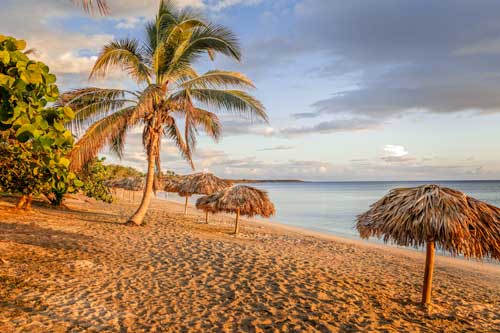

Ultimate Guide to Travel to Cuba (2024 Update)
Cuba is well known for its white sand beaches, delicious rum, and world-famous cigars… but you might be surprised learn just how much Cuba has to offer travelers. From incredible hiking destinations and wildlife preserves to fascinating historical sites and modern art galleries, Cuba is so much more than most visitors expect.
Unfortunately, there is a lot of confusion about who can travel to Cuba (hint: yes, Americans can travel to Cuba ! ) and how to travel to Cuba. Thankfully, Cuba travel is easy for just about anyone.
In this ultimate guide to travel to Cuba, we’re covering a ll the details about how to travel to Cuba, the best things to do in Cuba, and why you need to add Cuba to your travel bucket list .
Plus, keep reading for all the inside tips we’re sharing about what to pack for your trip, and what to leave at home.

This post contains affiliate links that may reward me monetarily or otherwise when you use them to make qualifying purchases – at no cost to you. As an Amazon Associate, I earn from qualifying purchases. For more information, please read our disclosure policy .
Cuba at a Glance
Who can travel to cuba.
Everyone can travel to Cuba! – even U.S. citizens or citizens of other countries traveling through the United States. U.S. citizens are required by the United States government to only spend money at private businesses (rather than government-run establishments) while there – which is quite easy to do.
Read More: Ultimate Guide to Travel to Cuba from the United States
Cuba uses the Cuban peso , valued at 24 pesos to $1 USD . However, since 2021 Cuba has been experiencing high inflation, and the official exchange rate is much lower than the one you’ll find if you exchange your money with a moneychanger.
Read More: Currency in Cuba: Ultimate Guide to Changing and Using the Cuban Peso
Spanish is the only language spoken in Cuba, with English occasionally spoken in the tourism industry . Download Google Translate before your trip to help. Check out our guide to the apps you’ll need for travel in Cuba for more recommendations.
Cuba is known for being an extremely safe country , much safer than most other places in Latin America or the Caribbean.
Take precautions that would generally when traveling – don’t be excessively flashy with jewelry, hold on to your stuff well in crowded areas, etc. You can find more Tips for Visiting Cuba like these from a fellow traveler here.
Electricity
Some areas of Cuba use 110V electricity while others use 220V electricity , and you’ll find a mix of plug types in different places around the island. We recommend bringing along a universal travel adapter and electrical converter so you can use your devices while there.
Internet in Cuba isn’t everywhere yet, but it is generally easy to access , although slower than you may be used to. We wrote a complete guide to using the internet in Cuba with all the details.
We recommend using a VPN (Virtual Private Network) when using the internet in Cuba. Check out our complete guide to using a VPN in Cuba for more details.
Required Insurance for Travelers
Cuba requires that all travelers show proof of travel insurance coverage upon arrival. We recommend Visitors Coverage for American and Canadian citizens and World Nomads for those of other nationalities.
Read More : Ultimate Guide to Cuba’s Travel Insurance Requirements
Our Most Popular Cuba Guides
- How to Legally Travel to Cuba from the United States (It’s Easy!)
- Ultimate Guide to Havana, Cuba
- Ultimate Guide to Varadero Beach, Cuba
- How to Get the Tourist Visa to Cuba
- Cuba’s Required Travel Insurance: What You Need and How to Get It
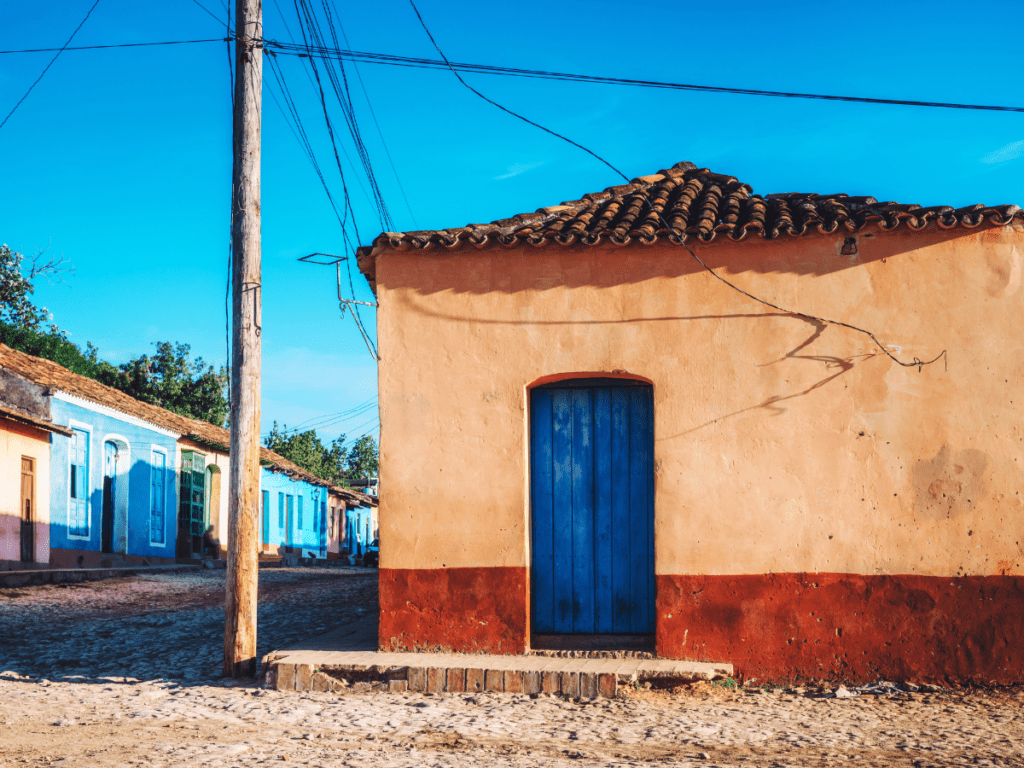
Weather in Cuba
A tropical country, Cuba has two seasons: the wet season and the dry season . The heat will generally dip slightly in the winter months (November through April) , but not much.
While the dry season generally attracts more tourists, the weather is perfect for a visit. May is a good time to visit as well, with the weather still nice and fewer tourists.
Dry Season: November – April
Wet Season: May – October
Don’t forget, Cuba occasionally experiences hurricanes . Peak hurricane season is from mid-August through mid-October.
Peak Tourist Season
Peak tourist season in Cuba lasts from early December through the end of March. Peak tourist season generally starts with a huge spike around the holiday season , when many Cubans living abroad come home to visit family.
Visiting around Christmas and New Year is when I’ve seen the greatest price increase in the price of flights and accommodations across the island – try to avoid these weeks if you can.
Best Things to Do in Cuba
Visit havana.
The craziest and most beautiful city in the world in our most humble opinion, Havana is like no other place on the planet.
Many say it’s stuck in the 1950s, but they couldn’t be more wrong – Havana holds on to its history beautifully while moving forward in a wholly modern way that will leave you enchanted.
Some of the best things to do in the city include exploring Old Havana , taking in the view over the city at the Cristo de la Habana , and ending the night with a drink and a show at the Fábrica de Arte Cubano .
Planning A Trip to Havana?
Check out our travel guides for insider information:
- Ultimate Travel Guide to Havana, Cuba
- Where to Stay in Havana
- The Best Airbnbs and Casa Particular Rentals in Old Havana
- The Best Airbnbs and Casa Particular Rentals in Vedado
- The Best Cafes in Havana and The Best Brunch in Havana
Visit Cuba’s Beaches
Cuba is known for having some of the world’s most beautiful beaches. Not only that, but many of them are as close to virgin, untouched beaches as you can still find in the Caribbean, which makes for an unmatched experience.
Check out our guide to the Top 10 Best Cuban Beaches to help you choose which to add to your itinerary.
The Beaches of Holguin
The province of Holguin is home to some of Cuba’s best beaches – Guardalavaca, Playa Pesquero, and Playa Esmeralda. Check out our ultimate guide to Holguin, Cuba for more details.
Varadero is the best-known beach in Cuba due to its proximity to Havana – it’s the perfect getaway from Havana for those looking to spend time in both the city and at the beach. If you’re picturing crystal clear waters and white sand , you’re thinking of Varadero.
While Varadero has a built-up infrastructure so you’ll have everything you’d want at your fingertips, there are also areas of Varadero where you can still get a slice of the beach all to yourself.
Read More: Ultimate Guide to Varadero, Cuba
Cayo Coco and Cayo Guillermo
This incredible pair of ‘cayos’ aka ‘keys’ located on the north shore of Cuba are served by their own international airport and have about a dozen large international hotel chains between them.
They’re some of the most underrated islands in the Caribbean .
If you’re looking for an all-inclusive beach experience, I recommend checking out these two keys and some of the incredible hotels they have to offer. The beaches here are truly pristine – some of the best beaches in Cuba .
Playa Ancón – Trinidad, Cuba
Playa Ancon is known as one of the most beautiful beaches on the southern part of the island, and is close to Trinidad, Cuba , an absolute colonial gem of a city that will take your breath away.
If you’re looking to get outside of Havana and Varadero track, which most travelers visit, we definitely recommend considering Trinidad and Playa Ancon!
Ride in A Classic American Car
The cars in Cuba are absolutely enchanting. While they’ve been kept on the road mostly out of necessity, it makes for a car-lover’s dream to see city streets packed with them.
A ride in a vintage convertible along Havana’s famous Malecón sea wall is a must while in Cuba.
Visit A Tobacco Farm in Viñales
Get up close and personal with one of Cuba’s most famous exports in Viñales , at the heart of the best tobacco-growing region in the country.
Here you can travel by horseback to beautiful tobacco farms where you’ll learn about how tobacco is grown, dried, and formed into world-famous cigars.
Viñales is also one of the most beautiful places in Cuba – this stunning valley is a UNESCO World Heritage Center . It’s an unforgettable way to see a stunning area of the country while this excursion!
What to Pack for Cuba
Check out our Ultimate Cuba Packing List to help you pack for your trip – we’re sharing exactly what to bring to Cuba and what we never travel without.
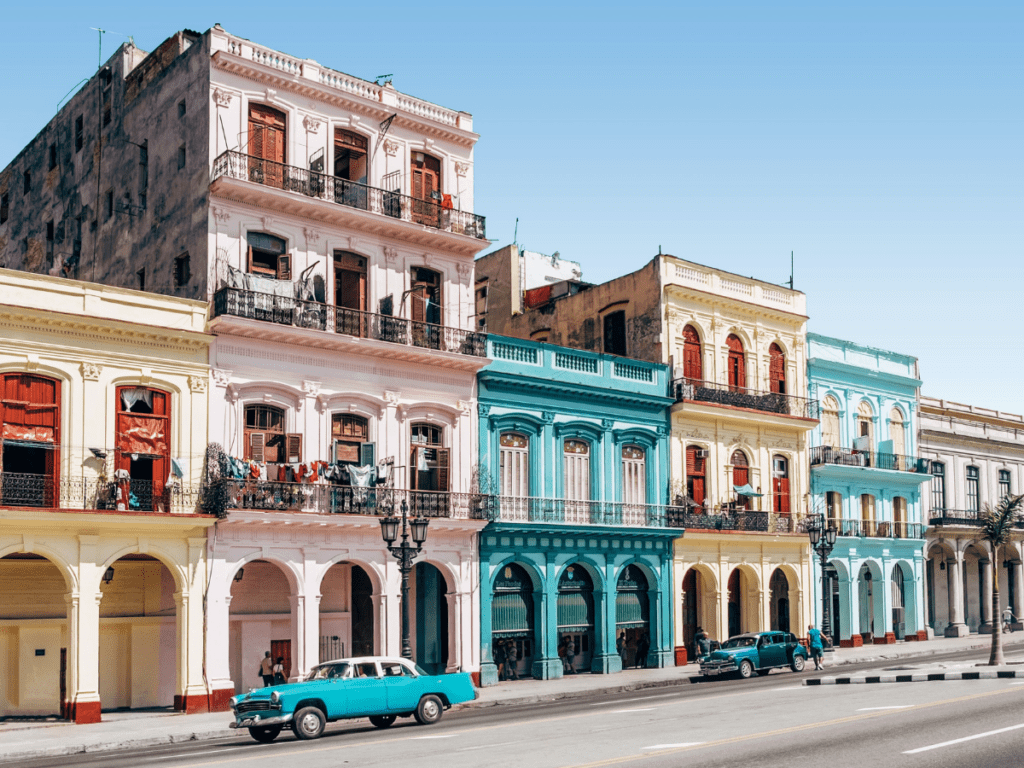
Learn About the Cuban Revolution
Cuba is so much more than the Cuban Revolution! The evidence of the revolution is everywhere, certainly, but there is so much more you’ll see and learn here as you meet the people, try the food, and see the art here in Cuba.
Make sure to visit these sites if you’re interested in learning more about the Cuban Revolution:
- Plaza de la Revolución in Havana
- Comandancia de la Plata in the Sierra Maestra mountains , the mountain base where Fidel and his band of revolutionaries launched their attacks
- Museo de la Revolución , a former presidential palace converted into the Museum of the Revolution in Havana. You’ll find American tanks captured in the attack on the Bay of Pigs behind the museum.
Learning more about the Revolution can be absolutely fascinating for visitors, and a great way to understand more of what you’re seeing and experiencing.
Make sure to check out this free walking tour in Havana focused on the Revolution as a fantastic way to learn more about what you’ll see in Cuba!
Want to learn more?
We made a list of a few books to read and movies to watch to inspire your travel and help you learn more about Cuba, past and present. Check them out before you go to learn more about the Cuban Revolution and much more.
- Books to Read Before You Travel to Cuba
- Movies to Watch Before You Travel to Cuba
Top Activities in Cuba
This list doesn’t even scratch the surface of what Cuba has to offer.
Make sure to check out our complete guide to the best travel experiences and activities in Cuba – totally travel-restriction compliant for travelers from the United States!
Where To Stay in Cuba
Casa particularles.
Casas Particulares – or, guest houses – are a fantastic option for staying in Cuba. You can find an amazing selection of rentals of all kinds, from luxury beach houses to staying with a family in a spare bedroom or renting a simple city apartment.
Not only do rentals usually get you a lot more for your money, but you’re supporting small business in Cuba and you’ll get a much richer cultural experience.
We’ve always had the best luck searching with, ironically, Hotels.com .
Despite their name, Hotels.com actually has a great selection of guest houses, private apartments, and Airbnbs for rent – with the best selection for Cuba!
Casa Particular Guides:
- Best Casas Particulares in Old Havana
- Best Casas Particulares in Vedado, Havana
- Best Casas Particulares in Viñales, Cuba
- Best Casas Particulares in Holguin, Cuba
Airbnb is one of the most popular platforms for finding rentals, but plenty of others exist as well and many people rent their listings across multiple platforms.
While we always recommend staying in a casa particular over a hotel, there are more and more amazing options in Cuba these days.
There are several new luxury hotels in Havana and in Cuba’s beach towns, but I recommend the boutique hotels like this one which can be just as luxurious and offer a more personalized stay.
All-Inclusive Resorts
There are many all inclusive resorts in Cuba, especially from companies like Iberostar and Melia , and they’re especially lovely ones located in Varadero and the Cayos – the Keys – on the northern coast of Cuba.
Cuba Accommodation Guides
- Where to Stay in Viñales, Cuba
- Where to Stay in Holguin, Cuba

Cuba can be a tough place to pack for – you’ll probably be combining time in the city, on the beach, or in the countryside.
Plus, there are a lot of things you just WON’T be able to find in Cuba no matter how hard you look, meaning you need to plan ahead!
We created an ultimate packing list for Cuba – so make sure to click through to this list to see all of our recommendations for packing (for men and women), plus important travel essentials!
Cuba Travel Essentials
- CASH – if you’re a U.S. citizen, you won’t have access to debit or credit cards while in Cuba . Check out our guide to traveling with cash in Cuba for more details.
- SteriPen – purify water from any source so you won’t get sick!
- Water Bottle (with water filter!)
- S-Biner locks for backpacks and purses while out and about
- Luggage locks
- Comfortable and lightweight basics – I love Los Angeles Apparel clothes for travel, especially to Cuba. These high-quality basics are perfect for layering, and mixing and matching for traveling light (PLUS they’re ethically produced in the United States).
- Go Toobs are the BEST for bringing toiletries.
- Make a mini first-aid kit with a few bandaids, aspirin, triple antibiotic, and alka seltzer just in case!
- Reef-safe sunscreen
- Light clothing that will keep you cool in the sun
- Comfortable shoes – get ready for a lot of cobblestones and uneven sidewalks
- Feminine Hygiene Products- I have NEVER been able to find tampons in Cuba – and the period products I have had to purchase there are incomparably bad. Absolutely come prepared, ladies!
- A electrical plug adapter and converter
- A tablet (we love the Amazon Fire !) pre-download some audiobooks and any TV shows or movies you’ll want to watch while you’re in Cuba… internet speeds in Cuba will make downloads slower than you’re used to or impossible.
- A spare memory card for your camera – also something that can be extremely challenging to find in Cuba!
- NordVPN or another Virtual Private Network service . Not a physical product, but something you shouldn’t travel without! Check out our guide to using a VPN in Cuba , and our guide to using a VPN for international travel .

Carley Rojas Avila
Carley Rojas Avila is a bilingual travel writer, editor, content marketer, and the founder of the digital travel publications Home to Havana and Explorers Away. She is a serial expat and traveler, having visited 40+ countries and counting. Carley has written for publications like Travel + Leisure, MSN, Associated Press, Weather Channel, Wealth of Geeks, and more. Find her front row at a Bad Bunny concert, befriending street cats, and taste-testing every pizza in Havana.
Explore Cuba
Plan your trip to cuba: best of cuba tourism.

Essential Cuba
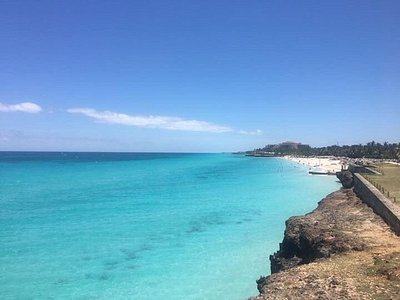
Trending in the forums

Cuba Is Great For

Eat & drink

The great outdoors

Art & history
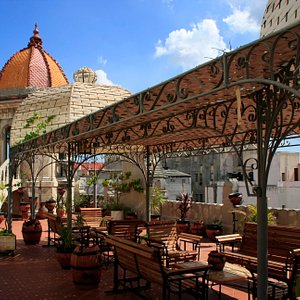
- Bay of Pigs
- Jardines De La Reina
- Isla de la Juventud
- Península de Zapata National Park
- Coppelia Park (Parque Coppelia)
- Walking Tour of Old Havana
- Havana Insights
- Havana Street Photography Workshop
- Walking tour La Habana
- Dare into modern Cuban cuisine

Cuba Travel Guide
Your ultimate cuba travel guide, with tips, things to do, and best things to see in cuba. great for first-time and returning travelers..
Located on the largest island of the Caribbean, Cuba is a very popular tourist destination and for good reason.
Cuba is home to beautiful white-sand beaches, impressive rainforests and waterfalls, vibrant culture, and lively cities .
Due to various trade restrictions over the years, Cuba has many described by many as like walking into a time capsule and is now a unique blend of the past and present, where vintage cars roam around colorful historic buildings and towns.
The birthplace of salsa music, Cuba is also full of rhythm. Add in its sub-tropical climate, and it is a great place to vacation.
This Cuba travel guide will help you plan your next vacation.
Popular Guides
- Things to do in Havana
- Cuba Photos
Our Highlight
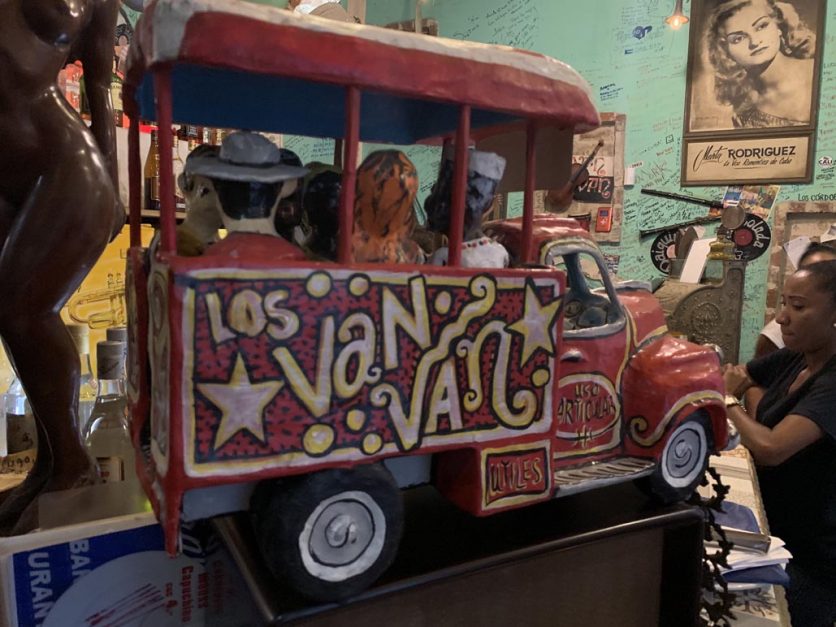
Table of contents
Table of Contents
Fast Facts about Havana
- Power voltage is 110V-220V at 60 Hz. Type A, B, C, and L.
- Cuba’s two currencies are the Cuban Peso and the Cuban Convertible Peso, mainly used for tourists.
- 1 Cuban Convertible Peso is equal to 1 USD.
- The best way to get around Cuba is by bus or taxi. If taking a taxi, make sure the taxi is licensed before riding.
- You need a tourist card to enter Cuba, as well as a passport that is valid for two months after your trip ends. The tourist card allows you to stay in Cuba for up to 30 days.
- The most popular cellular networks in Cuba are Cubacel and Digicel and both offer SIM cards. It should be noted the SIM cards can only be used on unlocked GMS phones. To rent a SIM card, you need a passport and your IMEI (phone ID) number.
- Cuba has a sales tax rate of 2% on wholesale sales and a 10% rate on both retail sales and services.
- SIM Cards : Cuba has very limited Internet and the best bet for visiting Cuba is to unplug, relax and if you have to, use your hotel’s limited WiFi for emergencies.
- It is advisable to download offline maps and any apps offline that you use to travel.
Things to See and Do in Cuba
- Hike Through Sierra Maestra: Cuba’s largest mountain range and the start point of the Cuban Revolution. Take a tour to learn more about Cuba’s history and enjoy a beautiful hike and great mountain views.
- Varadero Beach: Visit this pristine and popular beach in Sol Palmeras. Walk through the sand, swim in the clear waters, get to know other tourists or locals, or simply relax and take in the beautiful views.
- Old Havana: Old Havana is the city center of Havana is considered a crucial part of any trip to Cuba. Stroll through one-of-a-kind historic streets and buildings to see the history of Cuba.
- Tropicana Club: Head to the famous Tropicana Club for some great nightlife entertainment. Get dinner and enjoy the thrilling cabaret show that’s been running since the 1930s, featuring lively song and dance numbers.
Cuba Travel Guides
- 36 Fantastic Things to do in Havana, Cuba
Accommodation
Budget: Cuba offers family-run bed and breakfasts (or casas particulares) for around 15 to 25 pesos per night.
Mid-Range: For mid-range hotels, expect to pay roughly 70-130 pesos per night.
High-End: Upscale hotels will cost about 150-250 pesos per night.
Check out our favorite booking platforms Booking.com , Tripadvisor and VRBO for the best deals on accommodation.
If you’re on a budget, you can find options for pizza or spaghetti at around 3-4 pesos each.
Coffee lovers can find delicious cups of coffee for around 0.10 pesos. Restaurants are a good way to learn more about Cuban cuisine.
Expect to pay around 10-15 pesos for a meal at a restaurant.
The Best Ways to Get Around Cuba
Getting to cuba:.
Getting to Cuba: While there are 10 international airports in Cuba, the Aeropuerto Internacional José Martí in Havana is the main one, with the Gualberto Gómez International Airport in Varadero being a close second.
Flights: You can check for the best flights to Cuba on Skyscanner .
Transportation:
Transportation: Look for the Viazul buses, which are made especially for tourists and feature air-conditioning. Great for long distances, you can travel from Trinidad to Havana in six hours for just 25 pesos.
You will want to arrive at the station in advance to get a spot.
Trains : The train system in Cuba runs the length of the island and is a good way to meet the locals.
Go from Havana to Santa Clara for just 20 pesos, or from Santa Clara to Santiago de Cuba for 50 pesos. Be advised that the trains only run every few days, so planning ahead is key.
Taxis: Taxis are an alternative way to get around Cuba.
Fares start at 1 peso as a flat rate and increase by 1 peso for each kilometer traveled.
To travel from Old Havana to Miramar, for example, costs 8 to 12 pesos.
Car Rental: It is possible to rent a car in Cuba, but it is expensive and can be convoluted. Take care when you do. Check rates and availability here.
When to go To Cuba
Between November and April is the most popular time to go to Cuba, as temperatures range from 78 to 85 degrees Fahrenheit and skies tend to be blue.
You can find higher temperatures (up to 90 degrees) and lower hotel rates in August but note that hurricane season is between August through October.
Where to Stay in Cuba
Iberostar Grand Packard – Located on the Malecon and walking distance to Old Havana, this is the premier place to stay in Cuba.
Hostal Las Palmas :One of the most highly rated bed and breakfasts in Trinidad. Explore Trinidad and the Playa Ancon beach, which are both close by.
Suite Florencia : Built-in 1940, this colonial house turned hotel in Santa Clara is right in the middle of everything. Descend the white marble staircase into this romantic hotel.
Enjoy beautiful views of Santa Clara from your room, or roam about Santa Clara and visit the nearby restaurants and bars.
What to Pack for Cuba
Cuba has a tropical climate so you can count on it being hot and humid.
- Swimsuit: With Cuba”>
- Sunscreen: Protect your skin from the powerful sun with some sunscreen.
- Cash: As you may not be able to withdraw money from your bank accounts while in Cuba, make sure to bring an appropriate amount of cash based on what you think you’ll spend.
- We didn’t have a problem withdrawing from ATMs in Havana, but it is better to be safe
Cuba Travel Guide: Best Booking Resources
Whenever we travel to we make sure to start with these companies. We have tried a lot of different ones over the years and all of these have consistently proven to be the best when it comes to offering great prices.
We have used every one of these personally and continue to do so.
- Booking.com : This is our go site to when comparing prices for accommodation. It usually has the cheapest prices, especially in Europe and we love their interface. Not to mention you get free cancellation and you are guaranteed the best price.
- Trip Advisor : What we like about Trip Advisor is that we can look at all the reviews and then book our accommodation. TripAdvisor is where we go when we want to compare prices with multiple accommodation providers.
- VRBO : is the main search engine we use when we are looking for a home or apartment rental. It can sometimes be cheaper than hotels and it is the best way to stay in areas that offer a more local feel.
- Hostelworld : With one of the largest databases of hostels in the world, Hostelworld is the go-to site when you are looking for budget accommodation.
- Skyscanner : This is the first place we check for flights. It consistently comes back with the cheapest and best options. It allows us to compare a lot of airlines to get the best price.
- Rome 2 Rio : If you want to see how to get somewhere by plane, train, bus, ferry or car Rome2Rio lays it all out for you as well as related costs.I love how they show it all to you on a Google Map and it works offline.
- Get Your Guide: For all your day trip and city guide needs, we use Get Your Guide. It has the world’s largest collection of things to do with more than 30,000 activities in 7500 destinations.
- World Nomads Insurance: When traveling to Italy you should always have travel insurance. We have found the best bang for your buck is by far World Nomads.
Cuba Travel Guide: Related Articles
To browse all our articles and guides about Cuba Click Here.
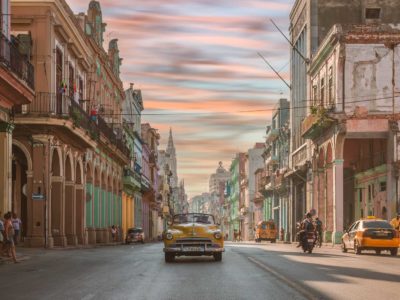
19 Unforgettable Places to Visit In Cuba in 2024
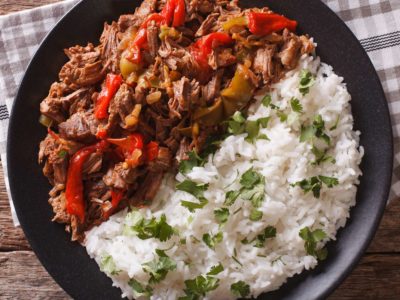
Cuban Food: 23 Cuban Dishes You Can Try at Home
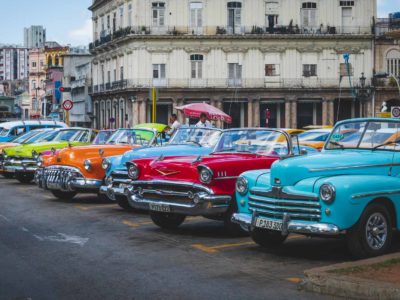
19 Fun Facts About Cuba You Never Knew

Yes, Americans Can Still Travel to Cuba. Here’s How
Is it legal for u.s. citizens to travel to cuba what types of travel can they take and what are cuba tourist cards here’s what you need to know about visiting cuba..
- Copy Link copied

Havana, Cuba’s capital city, is known for its vintage cars and historic architecture.
Courtesy of Spencer Everett/Unsplash
Cuba is a beautiful Caribbean island with a complex history and rich culture. But for decades, it’s been just beyond the reach of many Americans. In addition to several difficult years involving devastating hurricanes, pandemic-era travel restrictions, ever-changing U.S. State Department travel advisories, and frequently updated trade and tourism regulations , it’s not surprising that many Americans may be confused about whether and how U.S. travelers can legally visit Cuba .
As of early 2024, the short answer is: Yes, you can travel to Cuba as a U.S. citizen. There are, however, some hoops you’ll need to jump through, because (technically speaking) travel to Cuba for pure vacationing isn’t allowed. For U.S. citizens interested in planning a trip to Cuba, here’s what you need to know before you go.
Can you travel to Cuba?
The relationship between the United States and Cuba has been tumultuous, to say the least. Following the Cuban Revolution during the 1950s and the subsequent rise of Fidel Castro’s regime, diplomatic ties between the two nations deteriorated rapidly. In 1960, the United States imposed a trade embargo on Cuba, effectively severing most economic and political connections.
In the time since, travel between the two countries has been heavily restricted by the U.S. government, which has implemented various policies to discourage or prohibit its citizens from visiting Cuba. Making matters more complex, those policies often changed with each presidential administration. The island nation was more accessible during the Carter, Clinton, and Obama years and more closed off during the G.W. Bush and Trump years.
In 2014, it became significantly easier for Americans to visit Cuba after President Obama announced a series of measures aimed at normalizing diplomatic ties and loosening travel restrictions to allow Americans to visit for certain purposes (more on that later). Additionally, in 2016, commercial flights between the United States and Cuba resumed for the first time in more than half a century.
However, the Trump administration made it significantly harder to visit Cuba. During his time in office, President Trump enacted more than 200 measures against Cuba , which included limiting what Cuban airports flights from the U.S. could fly into, banning cruises from stopping in Cuba, and eliminating the most common visa category under which U.S. citizens planned legal visits to Cuba (known as “people-to-people” travel).
Then in May 2022, President Biden’s administration announced it would undo many of the Cuba-related restrictions enacted under Trump and would work on expanding authorized travel. Under the new order, regular passenger and charter airplanes are again allowed to fly to any Cuban airport (and airlines announced new flight paths ). And officials said that the “people-to-people” category of travel, under which many tours and organized travel companies bring U.S. travelers to Cuba, will ultimately return, though there is no timeline on when that will happen.

Cuba’s music scene is also a big draw.
Photo by Shutterstock
How to travel to Cuba as an American citizen
U.S. law states that those who want to go to Cuba need to qualify for a “general license” based on one of 12 approved categories.
The 12 categories currently authorized by U.S. government, for travel to Cuba are:
- Family visits
- Official business of the U.S. government, foreign governments, and certain intergovernmental organizations
- Journalistic activity
- Professional research and professional meetings
- Educational activities
- Religious activities
- Public performances, clinics, workshops, athletic and other competitions, and exhibitions
- Support for the Cuban people
- Humanitarian projects
- Activities of private foundations or research or educational institutes
- Exportation, importation, or transmission of information or informational materials
- Certain authorized export transactions
Licenses are self-qualifying, meaning that when you purchase your airline ticket, you’ll be asked to state your category in a signed affidavit before checkout.
When former President Obama first eased travel restrictions to Cuba , the move allowed leisure travelers to pursue self-led trips under the “people-to-people” educational activities category. Today, the “support for the Cuban people” category is the most popular because it’s the broadest.
What the “support for the Cuban people” license entails
To adhere to the requirements for independent travel under “support for the Cuban people,” travelers must first declare the category (when prompted) while booking flights and lodging. As part of the license, travelers are also expected to prepare an itinerary outlining how their trip will fulfill the category’s terms and contribute to Cuba’s local economy. (This itinerary could be—but isn’t always—requested on arrival to the country.)
An appropriate “support for the Cuban people” itinerary could including staying in casa particulares (locally run guesthouses), visiting Cuban-owned businesses, going on tours (like classic car rides or architecture walking tours) run by Cubans, visiting independent museums and galleries, partaking in cultural dance and music classes, and eating at locally owned restaurants and markets. (For specific recommendations and local resources, check out AFAR’s Cuba Travel Guide .)
Travelers can visit independently under that category, though it’s important you keep a record of your itinerary and your receipts: The U.S. government can ask for them up to five years after the trip.
Can you still travel to Cuba with organized tour operators?
Even though the Trump administration’s tightened restrictions on travel to Cuba prohibited organized “people-to-people” tours entirely, many tour companies have switched their approach to adhere to the “support for the Cuban people” license, according to Tom Popper, president of U.S.-based tour operator InsightCuba . Other tour providers that offer “people-to-people” trips, such as GeoEx Adventure Travel , Flash Pack , Intrepid Travel, and G Adventures, have similarly transitioned their program itineraries in order to offer legal trips to Cuba that comply with the regulations.
Challenges and considerations for travel to Cuba
Despite the easing of restrictions, traveling to Cuba as an American still presents some challenges. For example, there are limited banking services available to U.S. visitors, and American credit and debit cards are not typically accepted (as noted on the website for the U.S. embassy in Cuba ), so it’s important to bring plenty of cash. Similarly, internet access in Cuba is limited —expect connections to be patchy .
How to get a Cuba Tourist Card

The terms Cuba Tourist Cards and Cuban visas are sometimes used interchangeably.
Courtesy of Easy Tourist Card
Regardless of the license under which you travel to Cuba, you’ll still need to organize a few important documents before you go.
The Cuban government requires that all travelers entering the country provide a valid passport and proof of travel insurance that covers medical emergencies and evacuation by air. In addition, all U.S. travelers—adults, children, and infants—must purchase a Cuba Tourist Card , which grants visitors a maximum stay of 30 days on the island. Tourist Cards are valid for 180 days after purchase, which means you will need to travel within six months of obtaining the document. Note that the terms Cuba Tourist Card and Cuban visa are sometimes used interchangeably; they’re the same thing.
There are several ways to buy a Cuba Tourist Card: Many U.S. airlines with direct service to Havana—among them United Airlines , JetBlue , American Airlines , Delta , and Southwest —offer Tourist Cards either online or at the gate; prices and purchase locations vary among carriers, so it’s important to check in advance.
Websites like Easy Tourist Card allow travelers to apply for and purchase Tourist Cards online with two-day international shipping. Those who plan to fly to Havana directly from the United States will need to purchase a pink Tourist Card at a rate of $100, while those departing from non-U.S. airports can purchase a green Tourist Card for $37, even with a U.S. passport.
“U.S. travelers should note that travel to Cuba has been regulated since 1963 and has changed under each presidential administration since that time,” states Popper of InsightCuba. “Cuba travel has always been a hot political topic, and you never know when the rules are going to change. I always tell people to go now—while you can.”
This article was originally published in 2018. It was most recently updated on March 21, 2024, to include current information.

Cuba Tours & Vacations

Behind the hum of vintage cars, pastel hues of 16th-century buildings and wafts of cigar smoke, the real Cuba shines bright.
A country caught in a cultural time warp, Cuba is a bright snapshot of the mid-20th century; a true feast for the senses. Watch as Cadillacs roll down the coastal boulevards, walk through traditional tobacco plantations in Vinales and see cigar production in full swing, laze on the shores of the Caribbean on some of the world’s whitest sands, and feel the sultry and spicy vibes of salsa as you dance the night away in Havana. With all of this on offer in one of the world’s best climates, what’s stopping you from checking out Cuba’s kaleidoscope of color and charisma?
Our Cuba trips
Let's create an exclusive trip for your group.
Cuba tour reviews
Filter by rating
Premium Cuba
Cycle Cuba: East
Articles of Cuba
The art of Cuban casa hopping
10 things you’ll only know if you’ve travelled in Cuba
The top 7 destinations for travel in March 2024
A teen’s eye view of Intrepid family tours
Why you should say yes when your friend asks you to travel
How to avoid scams and Havana bad time in Cuba
Which style of Latin dance suits you?
I went to Cuba for the cars and cigars, but it’s the people that’ll stay with me
Cuba at a glance
Capital city.
Havana (population 2.1 million)
11.3 million
(GMT-05:00) Bogota, Lima, Quito, Rio Branco
CALLING CODE
Electricity.
Type A (North American/Japanese 2-pin) Type B (American 3-pin)
Learn more about Cuba
Culture and customs.
With Spanish , African , and Creole influences, modern Cuba is home to so many cultural components – some of which don’t feel super ‘modern’ at all!
You won’t be surprised that Cubans love music and dancing – with everything from Afro-Cuban rhythms to classic melodies filling the air in clubs, bars, restaurants, and on street corners. The modern arts are also alive here, with ballet, contemporary dance, and film rising in popularity – so much so, Havana is now home to internationally recognized film, literature, and music festivals.
Living in a Communist country means Cubans sometimes go without the luxury items that many Westerners take for granted, with certain foods and consumer goods not available. Despite this, events like birthdays, holidays, and marriages are celebrated with gusto, with special meals, music, and dance featuring. This love of life is also evident in the street parties, festivals, and fiestas that are celebrated throughout the year. Coffee, cigars, and rum flow freely, and people dance to the sound of trumpets and guitars in city streets.
Life in the cities and life in rural areas can be quite different, but the pace of living is consistently Cuban – you’re on local time now, so go with the flow. Experience Cuban culture on our 8 day Beautiful Cuba trip.
History and government
Ancient history.
Before the arrival of the Spanish in 1492, Cuba was home to Mesoamerican cultures, including the indigenous Guanajatabey and Taino people. The Guanajatabey were hunter-gatherers and fishers, and Taino communities also harvested yuca, cotton, and tobacco. Spanish colonialist Bartolome de las Casas estimated that Taino populations in Cuba had reached 350,000 by the end of the 15th century.
By then, Christopher Columbus had landed in Cuba and claimed the land for Spain, naming it Isla Juana. In 1511, Diego Velazquez de Cuellar founded Baracoa, the first Spanish settlement in Cuba, and three years later what’s now known as Havana was built.
20th century
In 1902, after periods under Spanish, British, and United States rule and involvement in the Spanish–American war, Cuba got its independence. Despite the economy booming, leaders at this time ruled through corruption and control. This was until revolutionary Fidel Castro led a 9000-strong guerrilla army into Havana in 1959, forcing military dictator Fulgencio Batista to flee. Castro became the leader and his brother, Raul, his deputy. What followed was an attempt by the United States to overthrow Castro’s communist rule at the Bay of Pigs, and tension and trade embargoes following the 1962 Cuban Missile Crisis.
Standing alongside Castro as an equally prominent political figure, Che Guevara (although Argentinean) holds a very important place in Cuban history. A revolutionary, author, doctor, and military leader, Guevara played a pivotal role in the guerrilla campaign leading up to the Cuban Revolution and the defense of the Bay of Pigs, as well as in diplomatic relations, up until his death in 1967. It’s impossible not to notice the reverence for Guevara when visiting Cuba, with street art, statues, and museums dedicated to the man Cubans simply call ‘El Che’ found all over the country.
In April 2011 Fidel Castro was succeeded as the First Secretary of the Communist Party of Cuba by his brother Raul Castro. Cuba’s political relationship with other countries, including its close neighbors, is ever-evolving, with the US recently beginning to ease restrictions on trade, tourism, and other industries. But a snapshot of 50 years of isolation remains in the cars, architecture, and culture that is a contemporary Cuban street. Learn about Cuba's fascinating past on our 15 day Best of Cuba adventure.
Eating and drinking
Cuba may not have culinary fame compared to some of its neighbors, but that doesn’t mean you’ll be missing out on some great food during your time here. Cuba typically doesn’t have access to a wide range of ingredients, so your dining experience may not be as varied as you’d expect from some other nearby destinations. Regardless, there are some Central American favorites that are definitely worth trying. Try out the local cuisine on our 8 day Cuba Highlights tour.
What to eat in Cuba
Pastelitos These small pastries can be either sweet or savory. Cream cheese, guava, and beef are the most popular fillings and make for a cheap, tasty meal on the run. Think empanadas, Cuban style.
Cuban sandwich Otherwise known as a mixto, this sandwich is a simple snack that has made its way north into Florida and has become one of the quintessential images of Cuban food beyond its borders. Ham, pork, cheese, mustard, and sometimes salami layered between bread and grilled – what’s not to like?
Ropa vieja Not only is this one of the national dishes of Cuba, but it’s also found all over the Caribbean, in Spain, and even the Philippines! It may literally translate to ‘old clothes’, but that’s definitely not what it tastes like – slow-cooked pulled beef with vegetables, usually served with maduros (fried plantains), black beans, and rice.
Fritura de maiz These deep-fried cheese and cornmeal fritters are popular street food snacks in Cuba. A great choice for vegetarians; throw a couple of these back and you’ll be feeling the Cuban spirit.
Moros y cristianos
Rice and beans is ot just rice and beans. Black beans and white rice are added to a base of peppers, garlic, and onion and simmered with herbs, creating a flavorful addition to any meal and served up at virtually every Cuban restaurant you'll come across.
If you're a little bit peckish and are on the go, seek out some tostones. These twice-fried plantain chips are very popular in a lot of Latin America countries and are an easy (and often cheap) snack.
Although flan is known all around Central and South America as an essential dessert, Cuban flan has a slightly different spin. It's made with evaporated and sweetened condensed milk, giving it a thicker and creamier caramel custard finish than fresh milk varities. Get ready for a seriously delicious sugar high.
Coppelia ice cream Line up with locals to savor a sweet scoop from Coppelia ice cream parlor. This Cuban institution serves tried and true flavors like chocolate and vanilla as well as exotic favorites like mango and coconut.
What to drink in Cuba
Rum The tipple of choice in Cuba is rum, obviously. Savour some Havana Club straight up, have it mixed in a minty mojito, or sip on a Cuba Libre – rum, cola, and lime.
Coffee Cuban coffee is of legendary quality, so be sure to get your caffeine hit with a small but rich cup of liquid gold. Drink it like the locals do, as a cafecito or Cafe Cubano. This type of espresso-style coffee is usually sweetened with raw cane sugar and stirred in with the first drips of espresso to get the best result.
Geography and environment
This island nation sitting in the Caribbean Sea is home to a diverse range of environments: rolling hills to tobacco plantations, beaches, and coral reefs to tropical rainforests. With more than 20% of the island covered with natural parks, there's incredible biodiversity, making it a great place for eco-adventures, hiking, snorkeling, and diving.
Large cities like Havana evoke a time gone by. Grand buildings dating back to the 1950s exude a fading beauty, which makes for great photographs but can also make daily life quite difficult. Due to a lack of building materials, new housing, and infrastructure are rare, making living conditions quite cramped for Cuban city dwellers. Rural life offers more space and a quieter pace, but reduced access to services. Regardless of where you holiday in Cuba, the people are generally kind and hospitable in both the big cities and small towns. Wander the magnificent landscapes, both natural and manmade, on our 8 day One Week in Cuba adventure.
Cuba may not be known for its shopping, but look closely and you’ll find lots of unique souvenirs to take home as a reminder of your holiday. Before heading home, check with your local customs officials to ensure that you are able to import some items back into your home country. Australia and New Zealand, for example, have strict quarantine laws. The United States also has restrictions on the amount of tobacco and alcohol that can be brought back from Cuba.
What to buy
Art Cuba has a keen appreciation of the fine arts, so it’s not hard to find unique artworks by up-and-coming local artists being sold at galleries and markets. It also makes for a meaningful memento of your time away.
Cigars The cliche is unsurprisingly true – cigars are everywhere in Cuba. Be sure to buy cigars from authorized sellers, as fakes are common. Purchasing straight from the factory is usually best.
Coffee Cuban coffee is top quality, so stock up before you leave to enjoy a taste of Cuba in the comfort of your own home. Do check, however, if your country of origin allows plant-based materials to pass through quarantine.
Music With such a rich musical heritage, Cuba is a great place to pick up a hand-crafted instrument or, if traveling light, a CD or a local artist’s info to add to your playlist.
Do some serious souvenir shopping on our 8 day Premium Cuba tour.
Festivals and events
Havana international jazz festival.
Local and international artists head to Havana every January to become a part of the happening jazz scene. From the impressive Teatro Nacional de Cuba to the city streets, the sweet sounds of jazz fill the air of Havana for the duration of the festival.
Habanos Cigar Festival
In February, cigar connoisseurs gather to celebrate their love of the best cigar in the world – the Habano. With tastings, visits to plantations and factories, master classes, and cigar-rolling contests on offer, this festival will intrigue curious travelers and delight cigar enthusiasts.
Santiago de Cuba Carnival
Watch this historic city come alive in July with street parades full of vibrant costumes, drums, and dancing. This epic public celebrations date back to at least the 17th century and are held all around the country, but Santiago de Cuba hosts the biggest, brightest, and most traditional of them all.
Similar destinations
Thinking about a trip to Cuba but still browsing other destinations? Or, maybe you've already traveled to Central America and you're looking for somewhere similar? Check out tours to neighboring locations:
Further reading
For inspiring stories to prepare you for your holiday in Cuba, check out these books:
- Our Man in Havana – Graham Greene
- Before Night Falls – Reinaldo Arenas
- Broken Paradise – Cecilia Samartin
- Take Me with You – Carlos Frias
- Adios, Havana – Andrew J Rodriguez
- Blessed by Thunder: Memoir of a Cuban Girlhood – Flor Fernandez Barrios
- Conversations with Cuba – C Peter Ripley
- Havana Fever – Leonardo Padura
- The Mambo Kings Play Songs of Love – Oscar Hijuelos
Cuba travel FAQs
Do i need a covid-19 vaccine to join an intrepid trip.
Trips from 1 January 2023 onwards
From 1 January 2023, Intrepid will no longer require travelers to provide proof of vaccination against COVID-19 (excluding all Polar trips and select adventure cruises).
However, we continue to strongly recommend that all Intrepid travelers and leaders get vaccinated to protect themselves and others.
Specific proof of testing or vaccination may still be required by your destination or airline. Please ensure you check travel and entry requirements carefully.
When is the best time to visit Cuba?
Cuba's subtropical climate is ideal for exploration, with most places catching the cool trade winds that blow in from the coast, providing pleasant year-round temperatures. June, July and August are usually the hottest months – the dry season runs from November to April and the wet season from May to October. Even in the rainy season, downpours are short and shouldn't impede travel plans. Tropical storms and hurricanes are more prevalent in September and October but rarely cause problems for travelers.
Do I need a visa to travel to Cuba?
Tourists of most nationalities require a 'Tourist Card' which is similar to a tourist visa. These can be obtained through travel agents in your home country, or directly from Cuban embassies and consulates. Depending on the airline you are traveling with to Cuba, you may also be able to purchase the tourist card at the airport from the airline on the day of your departure – please check with your airline for more information.
If you are a US citizen, American permanent resident, or hold any type of American Visa and are considering traveling to Cuba, please refer to the US Department of State Bureau of Consular Affairs website – travel.state.gov – for the latest advice.
We recommend traveling to Cuba via Canada, Europe, and South or Central America. Travelers who have been to Cuba are ineligible to participate in the ESTA Visa Wavier Program and must apply for a tourist visa to enter or transit via the United States.
Remember to check the entry requirements for any destinations you will travel or transit through both to and from Cuba.
The page is for general information only and may be subject to change. It is your responsibility to obtain relevant visa and travel information required for entry, departure and travel to each country or region you visit on your trip. You should confirm these with the relevant embassies and/or consulates.
Last updated: 14/11/2023
Is tipping customary in Cuba?
As most Cubans live modest lifestyles, leaving a tip for good service is a great idea and welcomed.
There is almost always free entertainment in bars and restaurants; the musicians and singers are usually not paid by the venue, so we encourage you to tip when you have enjoyed the performance. Tour leaders, restaurant workers, hotel porters, cleaning staff and taxi drivers will appreciate a small sum – but be sure to tip in Cuban pesos as foreign currency isn’t easily exchanged in Cuba.
It’s important to carry around small denominations of currency to leave tips during your holiday, so you can tip an amount you feel comfortable with.
What is the internet access like in Cuba?
Internet access isn't widespread throughout Cuba, but availability is improving. The internet can sometimes be accessed from government departments and larger hotels, and main squares in many cities now have wi-fi accessibility. You will need to purchase an internet card from certain hotels and outlets to gain access in any location, including in public areas.
Please note that although connectivity is improving, the connection may still be slow, some websites may be censored, and the cost is typically quite high.
Can I use my cell phone while in Cuba?
Your cell phone may or may not work while in Cuba, depending on what type of phone you have. Before leaving your home country, ensure roaming is activated with your provider, but be aware that your phone may not get reception due to Cuba having the lowest cell phone network penetration in Latin America.
If you intend to activate global roaming while in Cuba, be sure to check with your service provider to find out about any fees you may incur when using this option, as sometimes this can be expensive.
What are the toilets like in Cuba?
Public toilets are rare in Cuba, but western-style flushable toilets are available in hotels, bars, and restaurants. Bringing your own toilet paper and hand soap or hand sanitizer is recommended as often these are not provided. Due to import restrictions, toilet seats can be considered a luxury and may be missing from some facilities.
What will it cost for a...?
Cuba's unit of currency is the peso (CUP). Here's what you can expect to pay for a:
- Can of soft drink or bottle of water = 1-2 CUP
- Cup of coffee = 1.50 CUP
- Cocktail = 2-5 CUP
- Meal in a nice restaurant = 120+ CUP
- One hour of wi-fi = 25 CUP
Can I drink the water in Cuba?
It's not advisable to drink water from the tap in Cuba. For environmental reasons, try to avoid buying bottled water. Fill a reusable bottle or canteen with filtered water if you can – your group leader will provide larger and less disposable water containers for refills on private transport days when they have the resources available. It's also best to avoid ice in drinks and to peel fruit and vegetables rather than eating washed or unwashed produce.
Are credit cards widely accepted in Cuba?
Some credit cards are accepted in Cuba (Visa and Mastercard are usually more widely accepted), although some cards linked to US banking institutions won't be accepted. Debit cards (even Visa debit) generally have problems working. We recommend you bring multiple cards from different banks to be sure you have access to funds. Ensure you also have enough cash and other forms of payment, as credit card facilities may not always be available.
What is ATM access like in Cuba?
ATMs are accessible in large cities like Havana and Santiago de Cuba but are rare and almost non-existent in other parts of Cuba. Ensure you have other payment options available in case you cannot access an ATM while traveling.
What is the weather like in Cuba?
Cuba enjoys Caribbean vibes all year round, and sits below the Tropic of Cancer, so you’ll enjoy a tropical climate with north-easterly trade winds that blow year-round.
May to October is usually considered the wet season, with higher maximum temperatures each day (around 90°F) and more sunlight each day, averaging 10 hours. September and October is hurricane season in the region, and this time of year is usually hot and overcast, with a higher chance of rainfall.
November to April is usually the drier season in Cuba, with maximum temperatures sitting around 79°F and an average of 8 hours of sunlight each day. The winter months are clearer, slightly more humid, and more comfortable than summer.
What public holidays are celebrated in Cuba ?
- 1 Jan: Liberation Day
- 2 Jan: Victory of the Armed Forces
- 1 May: Labour Day (International Workers' Day/May Day)
- 25–27 Jul: National Revolutionary Festival
- 10 Oct: Independence Day
- 25 Dec: Christmas Day
- 31 Dec: Year End Celebration
Other dates to look out for:
- 28 Jan: Anniversary of Jose Marti’s birth
- 19 Apr: Bay of Pigs Victory
- 8 Oct: Anniversary of Che Guevara’s death
- 28 Oct: Anniversary of Camila Cienfuegos’s death
- 7 Dec: Anniversary of Antonio Maceo’s death
Please note, Cuba public holidays may vary.
Is Cuba safe for LGBTQIA+ travelers?
Cuba has made some significant steps in recent years to ensure LGBTQIA+ rights in the country. Homosexuality is legal and accepted in Cuba, and there are some anti-discrimination laws in place for employment, service provisions, and gender identity. However, same-sex marriage recognition is still pending, and stigma still remains in some parts of society, especially in rural areas.
The Cuban National Center for Sex Education (CENESEX) works to support the LGBTQIA+ community in Cuba and hosts rallies to educate and advocate.
For more detailed and up-to-date advice, we recommend visiting Equaldex or ILGA before you travel.
If you are traveling solo on an Intrepid group tour, you will share accommodation with a passenger of the same gender as per your passport information. If you don’t identify with the gender assigned on your passport, please let us know at the time of booking and we’ll arrange the rooming configuration accordingly. A single supplement is available on some tours for travelers who do not wish to share a room.
Last edited: 14/11/2023
Is Cuba accessible for travellers with disabilities?
Intrepid is committed to making travel widely accessible, regardless of ability or disability. That’s why we do our best to help as many people see the world as possible, regardless of any physical or mental limitations they might have. We’re always happy to talk to travelers with disabilities and see if we can help guide them toward the most suitable itinerary for their needs and, where possible, make reasonable adjustments to our itineraries.
As Cuba has not had the same infrastructure development as other countries, you may find some mobility challenges when traveling. Havana’s streets are often crowded, and sidewalks can at times be rugged or even nonexistent. This is the same with other cities and towns around the country. Also, a lot of public transportation isn’t geared toward travelers who use a wheelchair, so private travel may be the only option to get around.
If you do live with a visual, hearing, or other impairment, let your booking agent or group leader know early on so they’re aware and suitable arrangements can be made. As a general rule, knowing some common words in the local language, carrying a written itinerary with you, and taking to the streets in a group, rather than solo, can help make your travel experience the best it can be.
Do I need to purchase travel insurance before traveling?
Absolutely. All passengers traveling with Intrepid are required to purchase travel insurance before the start of their trip. Your travel insurance details will be recorded by your leader on the first day of the trip. Due to the varying nature, availability and cost of health care around the world, travel insurance is very much an essential and necessary part of every journey.
For more information on insurance, please go to: Travel Insurance
How do I stay safe and healthy while traveling?
From Australia?
Go to: Smart Traveller
From Canada?
Go to: Canada Travel Information
From the UK?
Go to: UK Foreign Travel Advice
From New Zealand?
Go to: Safe Travel
From the US?
Go to: US Department of State
The World Health Organisation also provides useful health information.
Does my trip support The Intrepid Foundation?
Yes, all Intrepid trips support the Intrepid Foundation. Trips to this country directly support our global Intrepid Foundation partners, Eden Reforestation Projects and World Bicycle Relief. Intrepid will double the impact by dollar-matching all post-trip donations made to The Intrepid Foundation.
Eden Reforestation Projects
Eden Reforestation Projects are helping to mitigate climate change by restoring forests worldwide; they also hire locally and create job opportunities within vulnerable communities. Donations from our trips support restoration across planting sites in 10 countries around the globe. Find out more or make a donation World Bicycle Relief
World Bicycle Relief provides people in low-income communities with bicycles to mobilize school kids, health workers, and farmers in far-out areas – giving them access to vital education, healthcare, and income. Donations help provide Buffalo Bicycles – specifically designed to withstand the rugged terrain and harsh environment of rural regions – to those who need them most. Find out more or make a donation

17 Top-Rated Attractions & Places to Visit in Cuba
Written by Karen Hastings Updated Aug 30, 2023
Cuba, the Caribbean's largest island , drips with history, culture, and mystique. Live music wafts through the cobbled squares in Havana's World Heritage-listed Old Town , vintage cars still cruise the streets, and the beautiful old buildings in Cuba's colonial cities evoke the feel of a country frozen in time.
Cuba also abounds in natural beauty. This vast island has more than 5,000 kilometers of coastline, much of it rimmed by dazzling beaches. Coral reefs glimmer in the turquoise waters, and Cuba's lush countryside and sublime islands have played host to presidents; provided refuge to revolutionaries; and inspired writers from around the world, Hemingway among them.
With all this history and beauty, as well as superb diving and fishing, Cuba offers a depth and diversity few Caribbean islands can rival. Explore this captivating country with our list of the top attractions and places to visit in Cuba.
1. Old Havana (Habana Vieja)
2. varadero, 3. trinidad, 4. guardalavaca, 5. playa paraíso, cayo largo del sur, 6. cayo coco, 7. parque nacional viñales (valle de viñales), 9. the malecon, havana, 10. che guevara mausoleum, santa clara, 11. museo nacional de bellas artes, 12. castillo de san pedro del morro, santiago de cuba, 13. peninsula de zapata (ciénaga de zapata), 14. el nicho waterfalls, 15. parque historico militar, havana, 16. plaza de la revolucion (jose marti memorial), havana, 17. fusterlandia.
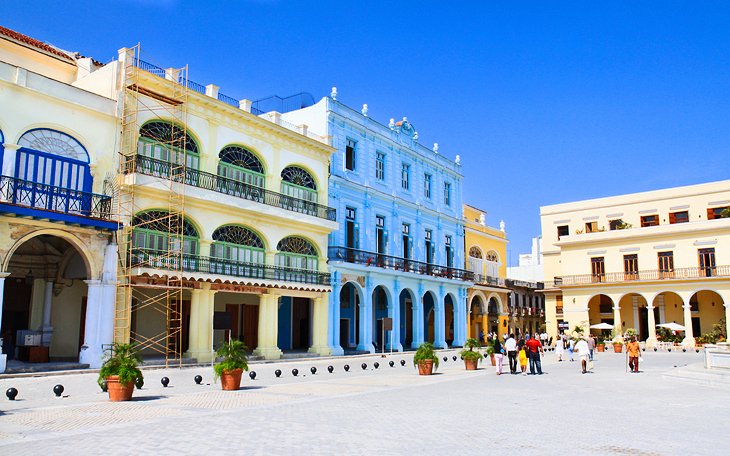
A UNESCO World Heritage site, Habana Vieja or Old Havana is a well-preserved slice of Cuban history. Strolling around the cobbled streets and gazing up at the grand Baroque and neoclassical buildings, it's easy to imagine what life in Cuba was like 200 years ago.
Extensive renovations are now breathing new life into the historic buildings. Major attractions here include the Plaza de la Catedral , home to the Cuban Baroque Catedral de San Cristobal ; the legendary restaurant and Hemingway hangout, Bodeguita del Medio ; and the military fortress, Castillo de la Real Fuerza .
Also in the Old Town, Plaza Vieja is one of the top places to visit in Havana . This vibrant gathering spot is home to some notable buildings, including the 18th-century Casa del Conde Jaruco , with beautiful stained-glass windows on the first floor. Nearby, the camera obscura offers fantastic views from its 35-meter tower.
The best way to explore Old Havana is to simply get lost along its cobbled streets. Colorful photo ops await around every corner, from the faded pastel-painted buildings to the clothes flapping in the breeze on washing lines and the candy-pink classic cars. Take time to watch kids play soccer in a square or listen to an impromptu musical performance. Allow at least a day to explore the Old Town and more if time permits.
Author's Tip: If you're seeking a more authentic Havana experience where you can connect with the locals, consider dining at paladars, small family-owned restaurants in private homes. They also tend to be cheaper than conventional restaurants. Similarly, if you're looking for an affordable place to stay, book a casa particulare. These homestays with Cuban families are another great way to save money and soak up the local culture.
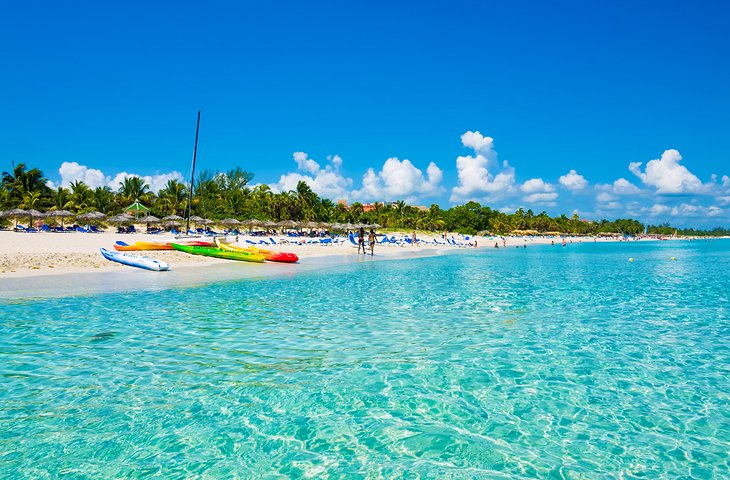
Varadero is one of Cuba's most famous beach destinations, and home to one of the best beaches in the Caribbean . It stretches along the Peninsula de Hicacos, which juts into the sea off the north coast; a drawbridge connects it to the mainland.
More than 50 beach resorts line this popular palm-fringed strip, and its magnificent white-sand beaches draw visitors from around the world.
Varadero highlights include Parque Ecológico Varahicacos (Varadero Ecological Park) , and its two caves, Cueva de Ambrosio and Cueva de Musulmanes.
For more subterranean adventures, Saturno Cave (Cueva de Saturno) offers a cool respite from the sun-blasted beach. Take a refreshing dip in the crystal-clear cenote, marvel at the giant stalactites and stalagmites, and jump off the surrounding ledges into the teal-colored pool below.
Also in Varadero, the peaceful Parque Josone is home to lush flower gardens, a restaurant, a swimming pool, and a small lake where you can paddle about in rowboats.
Other popular things to do in Varadero, besides diving and snorkeling, are deep-sea fishing, golf, skydiving, and day trips to cultural attractions.
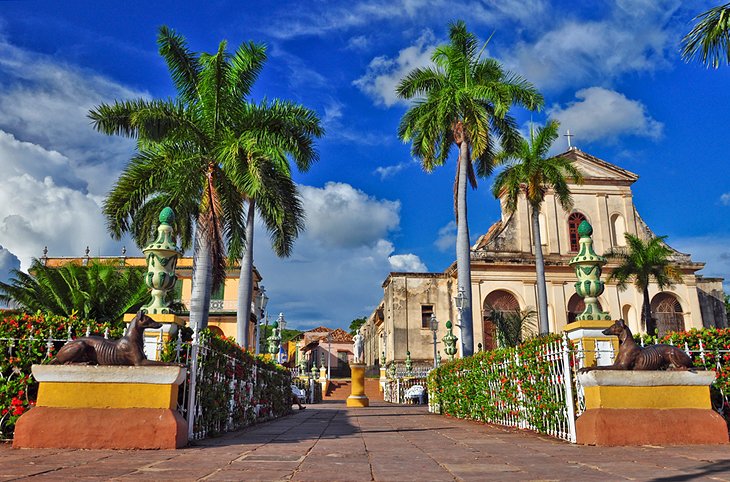
Exploring the town of Trinidad, Cuba, a UNESCO World Heritage Site, is like stepping back in time. The beautifully restored buildings and cobblestone streets in the city center exude a quaint colonial feel. Much of the architecture dates from the 17th to the 19th centuries, when Trinidad prospered from both the sugar and slave trades.
Today, Trinidad is one of the best cities in Cuba to visit, apart from Havana. You can soak up its lively ambience in the cobblestone Plaza Mayor , the city's central square. Above the square stands the neoclassical Church of the Holy Trinity (Iglesia Parroquial de la Santisima Trinidad).
Other Trinidad highlights are the Church and Monastery of Saint Francis (Iglesia y Convento de San Francisco), with its distinctive bell tower and the Palacio Brunet , a grand home built in 1812 and still featuring original frescoes and marble floors.
East of Trinidad, on the road to Sancti Spiritus , the lush World Heritage-listed Valle de los Ingenios contains numerous relics and monuments from the 19th century, when the sugar cane plantations and mills flourished. One of the best things to do in Trinidad, Cuba is simply drive or horseback ride through the beautiful scenery of green sugar cane fields, palm trees, and mountains.
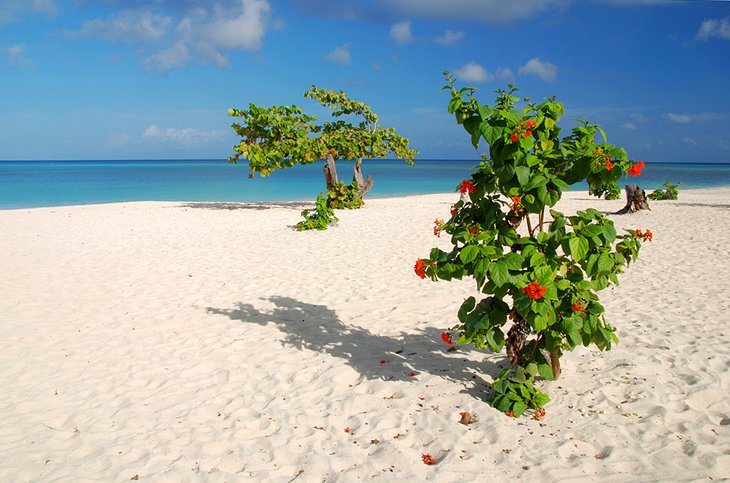
Rimmed by glittering beaches, Guardalavaca, in the Holguin province , is quieter and more remote than Varadero. Lush foliage fringes the sweeping strand of beach here, providing plenty of shady patches for those seeking respite from the tropical sun. Divers and snorkelers can explore a plethora of sea life along the coral reefs.
Day trips from Guardalavaca include jungle adventures, sailing trips, and sightseeing tours of Santiago de Cuba .
West of Guardalavaca, Bahia de Naranjo encompasses a large slice of coast and three islands, including Cayo Naranjo with the popular Dolphinarium , which offers close-up encounters with these gregarious creatures.
Chorro de Maita is another side trip option from Guardalavaca, with a native Indian burial area and a recreated Taino Indian village.
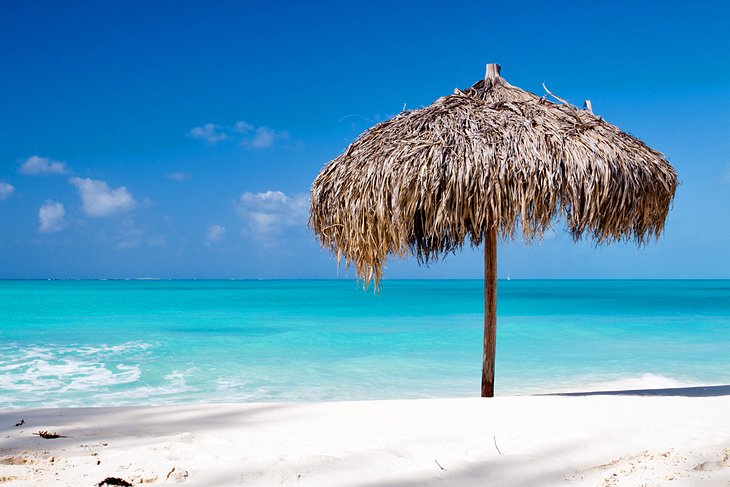
In a country known for its beautiful beaches, Playa Paraíso (Paradise Beach), on the island of Cayo Largo del Sur, is one of Cuba's best. This sublime strand of powdery white sand and baby blue sea skirts the sheltered western edge of the island and merges with the equally ravishing Playa Sirena.
The island of Cayo Largo del Sur is truly a sun seeker's destination with a typically dry, sunny climate and few tourist attractions besides some of the most beautiful beaches in Cuba and many hotels and resorts.
Note that sections of these beaches are clothing optional.
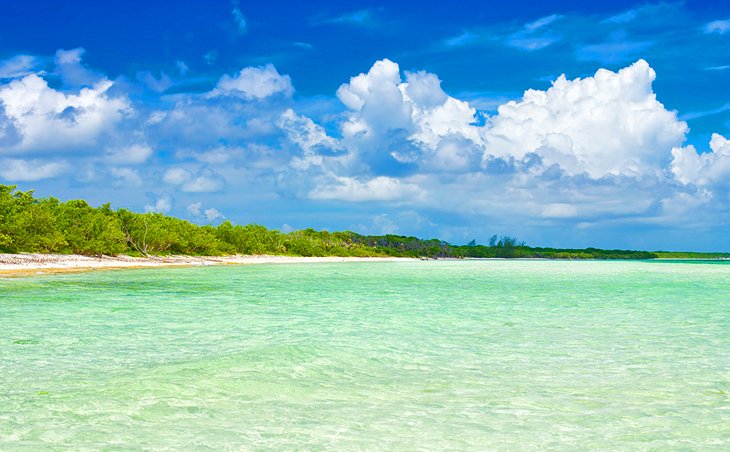
Cayo Coco is another of Cuba's idyllic beach destinations and one of its most isolated. The island starred in Hemingway's novels, Islands in the Stream and The Old Man and the Sea, along with nearby Cayo Guillermo .
As part of the Jardines del Rey , the combined archipelago of Sabana-Camaguey , Cayo Coco is connected to the mainland by a bridge, though most visitors arrive by air.
Sun-splashed beaches are the prime attraction. Playa Los Flamencos, on the Atlantic side of the island, is a standout with its five-kilometer strand of sun-bleached sand, and the quiet and undeveloped Playa Prohibida offers a peaceful nature trail. The island is also known for its excellent birding.
Connected by a causeway to Cayo Coco, Cayo Guillermo also boasts a bevy of beautiful beaches, such as the ravishing Playa Pilar, as well as a string of all-inclusive resorts.
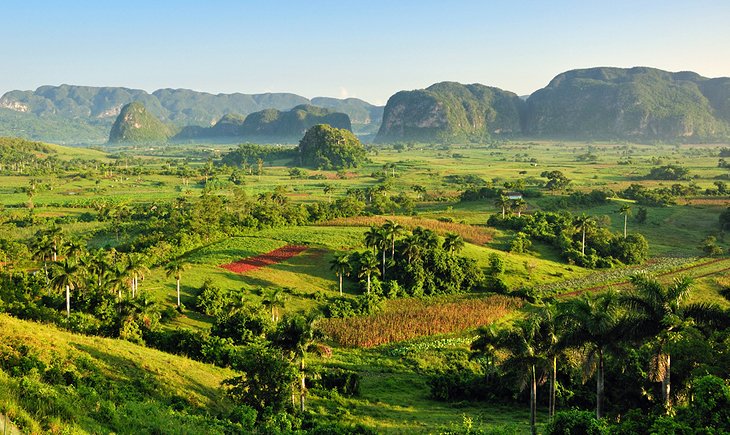
A UNESCO World Heritage Site , the Parque Nacional Viñales is a beautiful, verdant valley in the Sierra de los Organos, north of Pinar del Rio. Steep limestone hills, called mogotes, slice through the valleys, creating a dramatic landscape, and the wildlife
The valley floors in the Parque Nacional Viñales are agricultural areas where tobacco, fruit, and vegetables are grown. For outdoor enthusiasts, the park offers fantastic hiking and horseback riding in the hills. You can also tour coffee plantations, explore caves, and go rock climbing or ziplining here.
Nearby, the charming town of Viñales is a great base for exploring the surrounding area. Tour companies also offer day trips here from Havana.
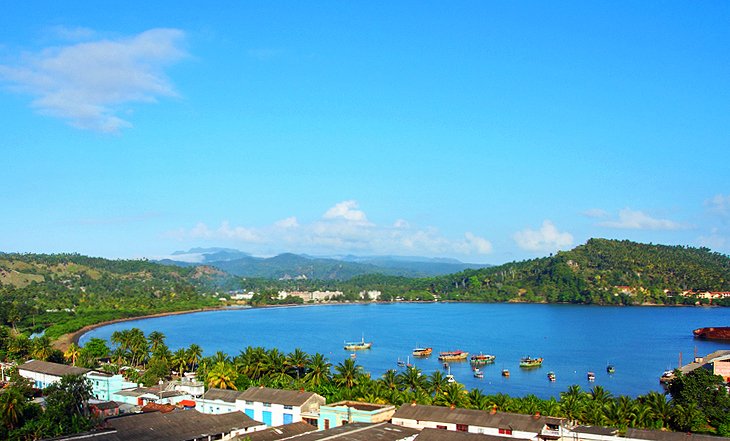
One of the highlights of eastern Cuba is beautiful Baracoa, the oldest city in the country. It was founded in 1511 in the province of Guantanamo, and construction began on the first church here around that time. Cut off from much of the outside world until the 1960s, when the La Farola highway was built, the city still has a remote feel.
Today, visitors come here for the charming colonial architecture and lush countryside, where waterfalls and pretty beaches provide a cool counterpoint to the steamy jungle. The flat-topped peak of El Yunque presides over all this tropical beauty, beckoning hikers to take the guided ascent to its 589-meter summit. The hillside is a UNESCO Biosphere Reserve where rare birds and plants thrive.
To really appreciate the spectacular scenery, take a drive down the winding La Farola highway , a 49-kilometer stretch from Baracoa over the mountains to Cajobabo .
The Museo Municipal is also worth a look. Housed in the Fuerte Matachin military fortress, it provides a glimpse of Baracoa's fascinating history, and the fort itself offers great views over the bay.
About 20 kilometers northwest of Baracoa is one of the area's best beaches: picture-perfect Playa Maguana . If you're looking for something adventurous to do in Cuba, you can rent a bicycle in Baracoa and peddle out here. Flights to Baracoa depart frequently from Havana.
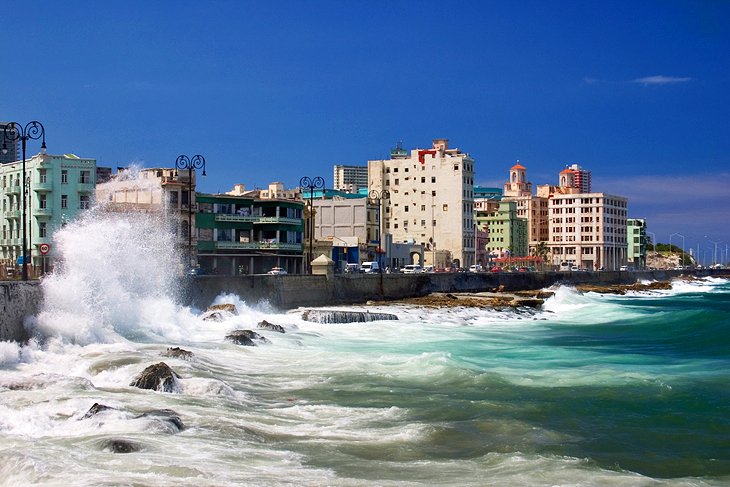
Conceived in 1901 and partly built in 1902 and beyond, the Malecon is Havana's famous seafront promenade. A walk along this top Havana attraction is a stroll through the history of the city.
The promenade runs seven kilometers from the Habana Vieja quarter to the Vedado, the central business district. Along the way, you will find an assortment of well-preserved 20th-century buildings that represent a mixture of architectural styles, including Art Deco and Neo Moorish. Painted in pastel pinks and yellows, the buildings are a photographer's delight, especially in the golden glow of dusk.
People-watching is a favorite pastime here. Young lovers saunter hand-in-hand, local fishermen cast their lines, and children clamber along the sea wall.
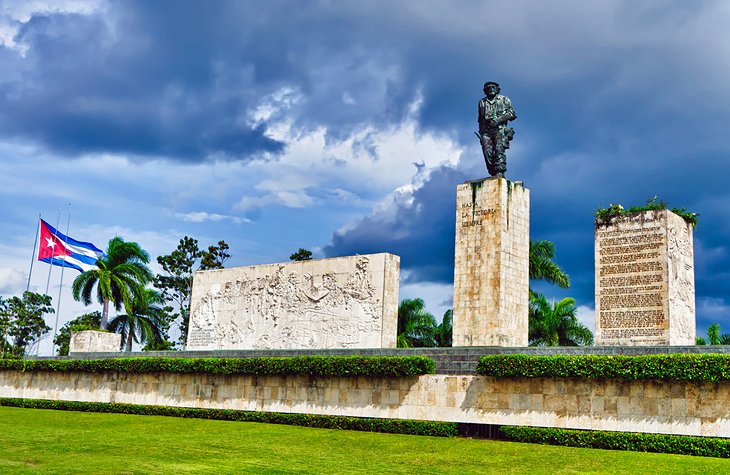
When beach towns and resorts all start to seem the same, and you're looking for unique things to do in Cuba, Santa Clara will add some depth to your Cuban itinerary. This is the famous site of the last guerrilla battle led by Che Guevara in 1958.
Che's body was laid to rest here, and his mausoleum (Mausoleo del Che Guevara) and monument, the Memorial Comandante Ernesto "Che" Guevara, are the town's big attractions. Etched on the bronze statue of Che Guevara in Plaza de la Revolucion is his final letter to Fidel Castro, while the mausoleum lies beneath.
Adjacent to the monument, the Museo Historico de la Revolucion exhibits some of Che's personal items. Che fans should also see the poignant Monumento a la Toma del Tren Blindado, a small boxcar museum and the site of the final battle between Che Guevara and the Batista troops.
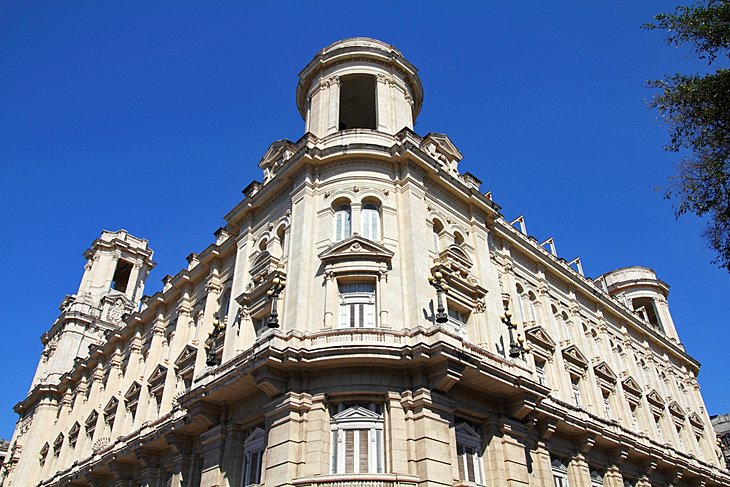
If you're an art lover, don't miss Havana's Museo Nacional de Bellas Artes (National Museum of Fine Arts), with its vast and impressive collection of international and Cuban art.
The collection is housed in two buildings and includes works from ancient times to the present day. Clad in sumptuous Italian marble, the restored Spanish Renaissance-style Palacio del Centro Asturiano was designed in the 1920s by Manuel Bustos. It displays international art, including works by European Masters; ancient art from Greece, Rome, and Egypt; and works from Asia, the United States, and Latin America. The Spanish collection, in particular, is a highlight.
The striking marble sculpture, Form, Space and Light , greets visitors at the entrance to the second venue, which dates from 1959. This Rationalist-style Palacio de Bellas Artes building displays a thought-provoking collection focusing on Cuban Art from the 17th century to the present day, including sculptures, prints, and paintings.
Palacio de Bellas Artes
Address: Trocadero Street e/Zulueta y Monserrate, Old Havana
Palacio del Centro Asturiano
Address: San Rafael, e/Zulueta y Monserrate, Old Havana
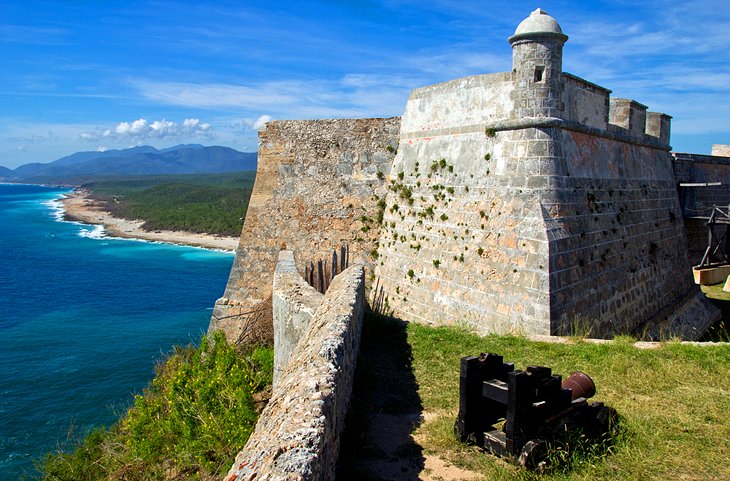
A UNESCO World Heritage Site, Castillo del Morro is one of the best-preserved Spanish fortresses of the 17th century. It stands at the entrance to the Bay of Santiago, about 10 kilometers southwest of Santiago de Cuba, the country's second-largest city.
Perched high atop a cliff, the structure was designed in 1587, but took decades to build and was finally completed at the end of the 17th century. It was originally intended to protect against pirate attacks, but also served as a prison in the late 1700s before being once again converted into a fortress.
Today, you can explore the many different levels of the fort, learn about pirates and the fort history in the small museum, and enjoy impressive views over the bay.
Other cultural highlights of Santiago de Cuba include the Diego Velazquez Museum and Cementerio de Santa Ifigenia , home to the remains of some of Cuba's most famous military figures.
Less than an hour from the city by car, Parque Baconao is a World Heritage Biosphere Reserve where you can tour coffee plantations, wander through beautiful botanical gardens, and enjoy stunning 360-degree views over the mountains and sea from the 1,234-meter summit of Gran Piedra, a large volcanic rock.
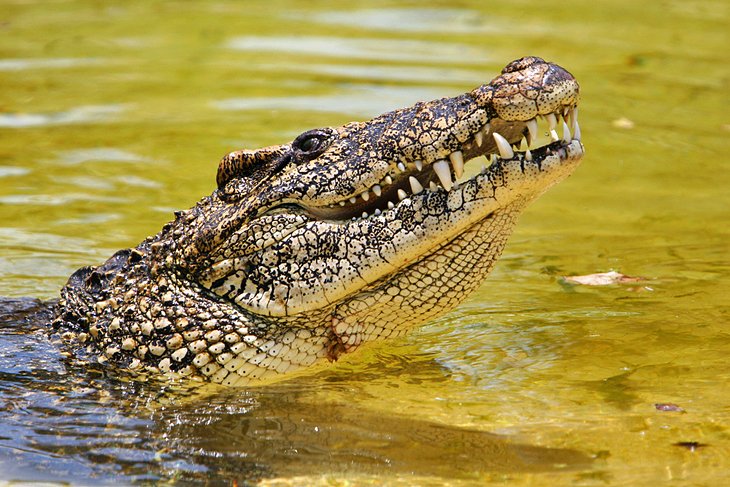
A haven for birders and nature lovers, the Peninsula de Zapata is a remote, sparsely populated area of Cuba with diverse landscapes and one of the largest wetlands in the Caribbean .
The Cienaga de Zapata, or the Zapata Swamp as it is affectionately known, is a UNESCO Biosphere Reserve, home to approximately 150 different species of birds, including waterhens, parrots, and herons. Crocodiles are also common.
One part of the peninsula is a designated nature reserve, the Gran Parque Natural de Montemar , where you can see some of these creatures in their natural habitats.
At the mouth of the Bay of Pigs (Bahia de Cochinos) is Playa Giron , the famous site of the 1961 Bay of Pigs Invasion. You can explore this fascinating history at the small Museo Giron .
At the top of the Bay of Pigs, Playa Larga is home to a long beach backed by lush vegetation. Avid divers can explore the underwater wildlife at numerous dive sites here along the reef.
Boca de Guama is the peninsula's tourist center, and its main attraction is the Criadero de Cocodrilos , a crocodile farm.
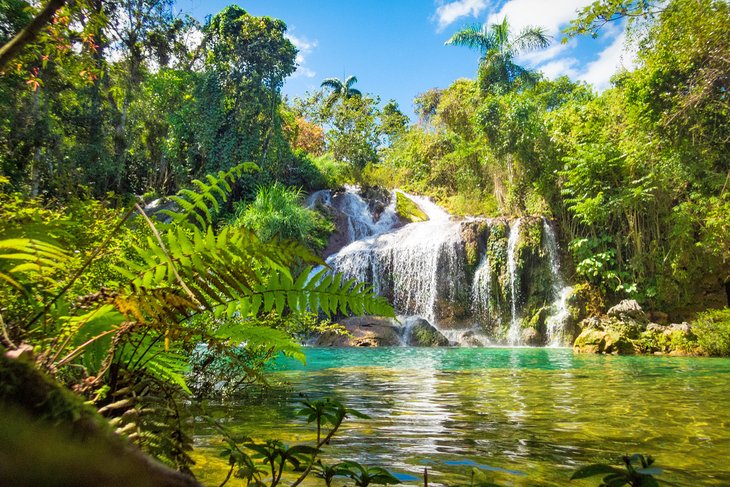
If you're looking for a ravishing slice of nature in central Cuba, head to El Nicho waterfalls. About a 90-minute drive from Trinidad or Cienfuegos, in Parque El Nicho , these multi-tiered falls flow into several jade-green jungle pools — the perfect place to take a cool dip on a hot day.
Driving here along the twisty rutted roads is an adventure in itself, and the scenery is beautiful. Once you arrive and pay the entrance fee, take the 1.5-mile palm-lined trail to the park's most scenic spots. It meanders along a cool river and ascends through thick, tropical forest to the falls, where you can swim and sunbathe. Along the way, keep an eye out for the tocororo, Cuba's national bird, and the beautiful royal palm.
Walk beyond the falls, and you'll end up at a scenic lookout with breathtaking views across lush valleys.
Wondering about things to do with the family in Cuba? This is the perfect back-to-nature excursion. Best of all, the waterfalls gush year-round — even in the dry season.
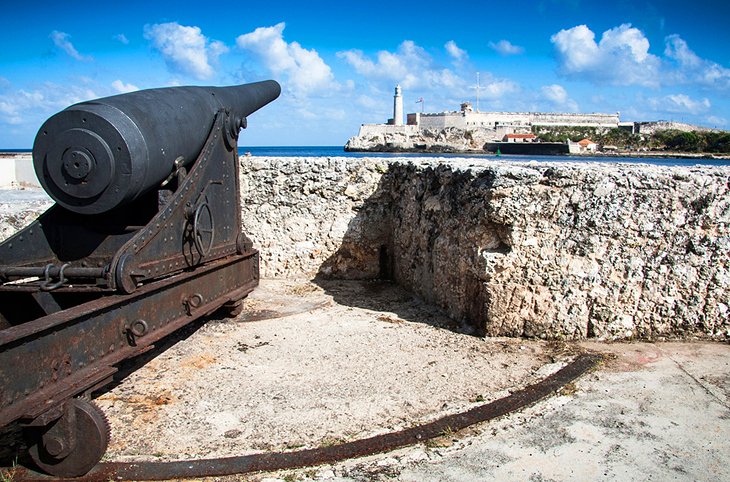
The Parque Historico Militar encompasses two of Havana's famous fortresses: the Castillo de los Tres Reyes del Morro , also known as El Morro, and Fortaleza de San Carlos de la Cabana .
Presiding over the entrance of the Bay of Havana, El Morro was built in the late 16th century and early 17th century to fend off pirates, and looks much the same as it did back then. The lighthouse was replaced with one of stone in the middle of the 19th century, but its original lamp still shines out to sea. You can ascend to the top of the fort to admire impressive views of the ocean and city.
A short stroll from El Morro, Fortaleza de San Carlos de la Cabana , constructed in the 1770s, was the biggest fort the Spanish ever built, as well as the most expensive. The fort became a military prison during the Batista regime and was later used as the headquarters for Che Guevara after the Revolution.
You can explore the museums here, which trace the history of this fascinating fort, but the most popular time to visit is at night when actors dressed in 19th-century costumes perform Ceremonia del Cañonazo, a cannon-firing ceremony, at 9pm.

Due to its important place in Havana's history, the Plaza de la Revolucion deserves at least a brief stop if only to absorb the events that transpired here. Castro delivered speeches in this vast square, attracting more than a million people at times. And in 1998, during a visit to Cuba, Pope John Paul II celebrated mass here.
In the center of the Plaza de la Revolucion stands a 109-meter gray tower, a memorial to the Cuban national hero, Jose Marti, while a large, white marble statue of him lies at its base. Below the statue is the entrance to the interior of the Jose Marti Memorial , which contains a museum on Marti. Ascend the tower for incredible views over Havana.
Opposite the memorial, the famous giant portrait of Che Guevara adorns the Ministry of Interior building. This is a popular spot for capturing Instagram photos, and you can also pose next to one of the colorful classic cars parked here.
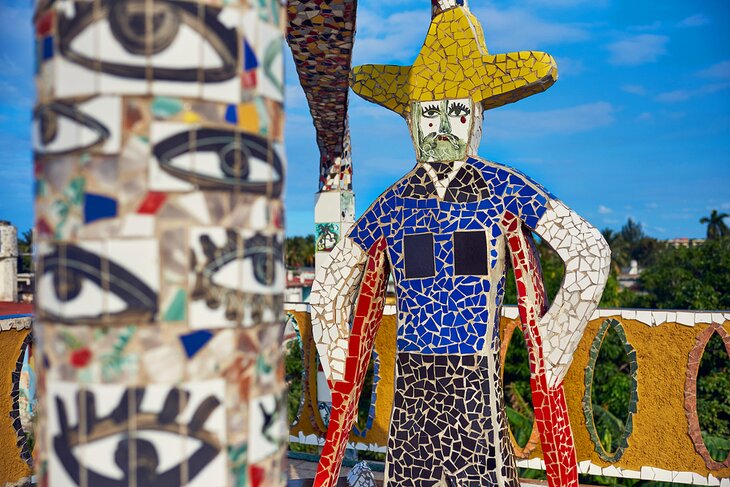
A riot of color and bucketloads of artistic inspiration is what you'll find at Fusterlandia. Mosaics, paintings, and sculptures in every color of the rainbow decorate this small neighborhood, which is actually called Jaimanitas. It's located about a 30-minute drive from Havana.
Local artist José Fuster, often called the Picasso of the Caribbean, is the artistic mastermind who transformed the neighborhood. A painter and sculptor, he created this striking display as a reflection of his life and art, even taking the time to decorate local bus shelters and his neighbors' homes.
After you click away at all the colorful art with your camera, pop by his home studio. Many Havana tours include a visit to this famous neighborhood, but you can also take the hop-on, hop-off tourist bus for a small fee. And if you really want to splash out, you can take a tour in a classic car.

More on Cuba
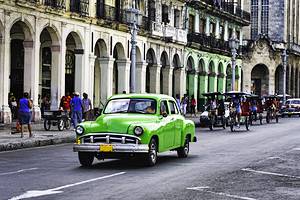
clock This article was published more than 1 year ago

Biden’s revised Cuba policy creates more options for U.S. travelers
The united states just approved flights to airports beyond havana and will restore the group tours banned under trump.

Americans who want to travel legally to Cuba will have more options after the Biden administration announced it was undoing some of the restrictions President Donald Trump imposed before the pandemic.
While a timeline for all of the changes is not yet clear, travelers should eventually be able to choose from flights to more destinations and take the kind of group-based educational trips that have been off-limits for nearly three years.
Under an order issued Wednesday by the U.S. Transportation Department, airlines will again be allowed to fly to Cuban destinations beyond Havana, an avenue that was cut off in late 2019. Public charter flights will also be permitted to go to airports outside Havana after being suspended in early 2020.
The Transportation Department issued the order rescinding the Trump-era restrictions after a request this week from Secretary of State Antony Blinken. He wrote that scheduled and charter air services could resume “effective immediately” once the department took action.
That formal request followed a May 16 announcement that the Biden administration was taking measures, including allowing the additional flights, to “increase support for the Cuban people in line with our national security interests.”
As Biden eases Trump’s sanctions, Cubans hope for an economic lift
Peggy Goldman, president and co-owner of two travel companies that bring visitors to Cuba — Friendly Planet and Insight Cuba — called the permission to add flights “wonderful news.”
“It makes it possible to enjoy much more of the island, and having these additional flights is a hallelujah moment for us,” she said. She added that her companies have been “badgering” airlines on a daily basis about increasing service.
U.S. carriers that offer scheduled flights to Havana, including American Airlines, JetBlue and Southwest, told The Washington Post this week — before the DOT’s order — that they did not have any additional services to announce. American Airlines flew to five destinations in addition to Havana until December 2019, and JetBlue once flew to three cities beyond the capital city.
“While we do not have any news to share at this time regarding changes to our operations in Cuba, we regularly evaluate new opportunities throughout our network,” JetBlue said in a statement.
Cuba reopened to visitors in November after closing its borders earlier in the pandemic.
Can Americans travel to Cuba? Yes, but it’s complicated.
U.S. officials have said that a popular authorized way for groups of travelers to visit Cuba — called “people-to-people” trips — will be back at some point. The Trump administration eliminated the option in mid-2019. The State Department said it would reinstate the option, along with other categories of group educational travel and some additional travel connected to professional meetings and research.
“We’ll certainly ensure travel is purposeful and in accordance with U.S. law. And we’ll note something that President Biden had said often, which is his belief that Americans are the best ambassadors for democratic values,” a senior administration official said on background during a press call last month. “And facilitating group people-to-people travel will allow for greater engagement between the American people and the promotion of their democratic values.”
The State Department did not release a timeline for reopening that category of travel, but it said in a statement that the administration is “working expeditiously to implement these changes, via regulatory amendments and other steps on an expedited basis.”
Collin Laverty, founder of Cuba Educational Travel, said people-to-people trips were a prominent way to visit Cuba before the Trump administration prohibited them. He described those trips as “having a full-time schedule that involves meaningful interaction with the Cuban people” — though independent tourism is not allowed.
Americans have been allowed to visit the island under categories that remain legal, including family visits, religious activities, competitions, educational activities and professional research, and meetings. After the Trump administration eliminated the “people to people” option, first for individuals and then for groups, most travelers opted to visit under the “support for the Cuban people” category.
Under that option, travelers need to have a full-time schedule of activities that enhance contact with locals, support civil society in Cuba, result in meaningful interaction with residents or promote independence from Cuban authorities, The Washington Post reported in 2019.
2019: Trump administration ends group travel to Cuba by Americans
The two categories were similar, but supporting the Cuban people required more direct aid to locals on the ground. Some tour operators told The Post when the changes were first announced a few years ago that they were skipping attractions such as Ernest Hemingway’s house and famous cemeteries. To keep their programming in compliance, they said, they would meet with craftspeople who make humidors instead of going to cigar factories, and they would visit artists in a studio cooperative instead of going to a museum.
David Lee, founder of Cultural Cuba, has always provided trips that meet the requirements of supporting the Cuban people and calls it “the best way to go by far.” But still, he and others said, the news about Trump restrictions being dropped had led to an increase in inquiries.
“Some of the changes that the Trump administration made definitely made people think they could not come to Cuba,” he said. “If this announcement has people believing, ‘Oh, it’s open again’ — even though it was always open ... and at least leads people to put Cuba back on their list as a destination, awesome.”
Laverty said he expects the return of U.S. travelers to Cuba to be slow, noting that he doesn’t see any regulatory changes that would lead to an “avalanche” in demand.
While the Biden administration’s goal is to expand authorized travel to Cuba, the State Department said the recently announced moves are not a return to the Obama-era policies that allowed cruise ships to visit the island and individual travelers to embark on people-to-people trips.
In Cuba, a desperate search for milk
Other Trump crackdowns prohibiting travelers from staying in military- or government-owned hotels remain in effect. They pose continued challenges to travelers and tour groups who have to find accommodations without those government or military ties.
“With new flights and group People to People programs being announced, more travelers will be able to visit Cuba safely but they will need more safe places to stay,” Michael Zuccato, CEO of Cuba Travel Services, said in an email.
Laverty said the last decade has brought “incredible development” in private-sector lodging, including privately owned apartments, rooms and boutique hotels. His company will sometimes split groups between multiple properties if needed.
“It definitely adds an extra logistical layer,” he said. “Trying to look at the positive side, it’s a really cool experience” where guests get to interact with their host and learn more about what it’s like to live in Cuba.
With economic hardships and severe shortages in Cuba that led to widespread protests last year, Laverty said he was concerned about what the travel experience would be like when his company started bringing Americans back earlier this year.
“What we’ve found over the last few months is U.S. travelers have really been exposed to shortcomings and challenges and also support Cubans through their travel and get an honest picture of the good and the bad in Cuba and still have a really great experience,” he said.
More travel news
How we travel now: More people are taking booze-free trips — and airlines and hotels are taking note. Some couples are ditching the traditional honeymoon for a “buddymoon” with their pals. Interested? Here are the best tools for making a group trip work.
Bad behavior: Entitled tourists are running amok, defacing the Colosseum , getting rowdy in Bali and messing with wild animals in national parks. Some destinations are fighting back with public awareness campaigns — or just by telling out-of-control visitors to stay away .
Safety concerns: A door blew off an Alaska Airlines Boeing 737 Max 9 jet, leaving passengers traumatized — but without serious injuries. The ordeal led to widespread flight cancellations after the jet was grounded, and some travelers have taken steps to avoid the plane in the future. The incident has also sparked a fresh discussion about whether it’s safe to fly with a baby on your lap .

Life in La Havana passes by surrounded by music, tradition, culture, national monuments and natural attractions of immeasurable value. Dances and Cuban “sones” spread to each one to this land’s children and to those who visit it as well; customs and traditions remain untouched and join new national and international celebrations to amaze visitors that plan a visit to La Havana, making it their Caribbean destination.
Havana, Cuban capital city, is located in the western side of Cuba and even when is the smallest of all the provinces, its over 2,000,000 inhabitants make it Cuba’s most populated one. Throughout its 15 districts, particularly in Playa, Plaza de la Revolucion, Centro Habana, Habana del Este and Old Havana (a UNESCO World Heritage Site since 1982), travelers will find numerous places of architectural, cultural and tourist interest.
Read more...
Visiting Havana is something you can do all year long. A warm weather most of the year, with temperatures that range from 68 to 85°F is the perfect incentive to explore the city. You can even plan your trips to La Havana to attend events such as the famous Havana Carnival, the International Ballet Festival of Havana and the International Festival of New Latin American Cinema (at the Hotel Nacional), in addition to congresses and symposiums of international reach that take place in the many spaces and venues for conventions and events of La Havana.
In the Cuban capital you’ll find the most generous tourist offer, which consists of national and international hotel chains with 2, 3, 4 and 5 star hotels , restaurants and cafeterias that offer the best Cuban and international cuisine to delight each and every single palate, travel agencies and first-rate transportation services.

What to Do in Havana
Declared one of the New7Wonders Cities in June 2016, Havana has something for everyone: from landscapes and ecotourist activities for outdoor adventure lovers and a golf course where international tournaments are held every year, to international marinas with first-class services for the traveler that enjoys water activities and sports.

Tips to organize your trip

Share Cuba Travel
Update April 12, 2024
Information for u.s. citizens in the middle east.
- Travel Advisories |
- Contact Us |
- MyTravelGov |
Find U.S. Embassies & Consulates
Travel.state.gov, congressional liaison, special issuance agency, u.s. passports, international travel, intercountry adoption, international parental child abduction, records and authentications, popular links, travel advisories, mytravelgov, stay connected, legal resources, legal information, info for u.s. law enforcement, replace or certify documents.
Share this page:
Cuba Travel Advisory
Travel advisory january 5, 2024, cuba - level 2: exercise increased caution.
Reissued with updates to crime information.
Exercise increased caution in Cuba due to crime .
Country Summary: Petty crime is a threat for tourists in Cuba. Also, violent crime, including armed robbery and homicide, sometimes occurs in Cuba.
Travel outside of the Havana area for U.S. Embassy employees requires a special notification process which may affect the Embassy’s ability to provide emergency assistance to U.S. citizens in Cuba.
Read the country information page for additional information on travel to Cuba.
If you decide to travel to Cuba:
- Be aware of your surroundings.
- Do not physically resist any robbery attempt.
- Do not display signs of wealth, such as wearing expensive watches or jewelry.
- Enroll in the Smart Traveler Enrollment Program (STEP) to receive Alerts and make it easier to locate you in an emergency.
U.S. citizens should always exercise caution when traveling abroad:
- Follow the Department of State on Facebook and Twitter .
- Review the Country Security Report for Cuba.
- Prepare a contingency plan for emergency situations. Review the Traveler’s Checklist .
Travel Advisory Levels
Assistance for u.s. citizens, search for travel advisories, external link.
You are about to leave travel.state.gov for an external website that is not maintained by the U.S. Department of State.
Links to external websites are provided as a convenience and should not be construed as an endorsement by the U.S. Department of State of the views or products contained therein. If you wish to remain on travel.state.gov, click the "cancel" message.
You are about to visit:
Best time to visit Cuba
Book your individual trip , stress-free with local travel experts
- roughguides.com
- best-time-to-visit-cuba
Plan your tailor-made trip with a local expert
Book securely with money-back guarantee
Travel stress-free with local assistance and 24/7 support

written by Joanne Owen
updated 25.04.2024
Boasting a bounty of beautiful beaches, along with extraordinary wildlife-watching experiences, adventure opportunities and festivals, Cuba has much to commend it whenever you visit. That said, the best month to visit Cuba depends on what you most want to do, and your budget, along with your opinion on the likes of tourist numbers, and the potential risks of the hurricane season. With these factors in mind, here we present the best time to visit Cuba from different perspectives. One thing’s for sure, Cuba is the kind of sparky destination that first-timers often find themselves longing to return to.
- Overview of weather and tourist seasons
December and January — best for winter sun and high season vibes
February and march — best for outdoor adventure, april and october – best for shoulder-season balance, may, june and september — best for budget travellers, july and august — best for high energy cuban culture, overview of weather and tourist seasons .
Cuba has a tropical climate, with a November-April dry season , and a May-October wet season. Though the dry season is generally considered to be the best time to visit Cuba, note that downpours are often (but not always...) short-lived in the wet season, and temperatures are high.
- The Atlantic hurricane season runs from 1st June through to 30th November, with September and October often being peak months for tropical storms and hurricanes.
- Coinciding with the dry season, Cuba’s tourist high season runs from November to April, though visitor numbers often drop-off from — and through — April.
- The wet season months of June, July, August and September see low season levels of crowds, and corresponding lower costs, with visitor numbers increasing through October as a drier period beckons.
- It’s also worth knowing that while July and August see smaller numbers of international visitors, these months are busy for local tourism.
They're also the hottest months of the year — worth bearing in mind when planning your Cuba itinerary , along with the factors detailed below.

Cayo Coco, Cuba © Shutterstock
Kicking off with the obvious, according to a huge number of travellers, the best time to visit Cuba is during the peak high season months of December and January.
Given that these months sit in the region’s dry season — at a time when many of us are seeking respite from colder climes — visitors to Cuba in December and January can expect gloriously sunny, rain-free days.
With warm temperatures sitting comfortably below the sizzling heat of summer, these are arguably the best months for enjoying the best beaches in Cuba .
At the same time, December and January being high season months means major tourist hubs (among them Havana , Varadero and Guardalavaca ) will be busy with like-minded travellers hoping for fun in the sun.
Beyond the entertainment offered by tourist resorts, this time of year sees Cuba stage a number of major festivals that are worth visiting for in their own right.
For example, Havana hosts an international film festival in December. Come January, celebrated jazz festivals take place in both the Cuban capital and Santiago de Cuba .
The flipside of these attractive reasons to visit Cuba in December and January are the usual high season trappings. By which we mean higher costs for flights and accommodation, packed attractions, and busy beaches.
That said, you could always opt to explore lesser-travelled paths on an independent backpacking adventure, or on a customised Cuba itinerary that’ll take you off the beaten track .

Love film and music? December and January could be the best time to visit Cuba for notable festivals in Havana © Shutterstock
Though still sitting in the dry high season, February and March see visitor numbers drop-off from their December and January peak. These months also offer optimal conditions for diving and snorkelling.
The same is true of hiking and biking. Being cooler than the heady heat of summer, but still dry and warm, these are top months to explore the country’s wilder walking trails. They're also a great time to take advantage of Cuba’s relatively car-free roads on a cycling trip .
On the subject of cycling, if that kind of active trip sounds appealing, take inspiration from our customisable Bike Cuba itinerary, or our longer Western and Central Cuba by e-bike itinerary.
Bird-watchers, note that this time of year sees over 260 migratory species flock to Cuba. Ciénaga de Zapata in the Matanzas province, and Peninsula de Guanahacabibes in Pinar del Rio are notable hotspots.
Editor’s tip: travelling with kids? Check out our Active Adventure Family Trip .

Visit Peninsula de Zapata in February and March for amazing birdlife © Shutterstock
If you’re looking for a balance between high season crowds, warm weather and more moderate rainfall, April might be the best time for you to visit Cuba.
Sitting at the end of Cuba’s main high season — though Easter sees a spike in visitor numbers — April is quieter than January-March. It’s also cheaper and warmer than the preceding months, and drier than the months that follow.
Nature-lovers will also want to note that turtle-watching season kicks off at this time of year. For example, if you visit Cayo Largo between April and September, you might just get to see loggerhead, hawksbill and green turtles come ashore to nest.
A similar kind of balance can be had in October, which isn’t as hot and humid as June-September. Bargains can often be had in October, too.
Just be mindful of the fact that the official hurricane season runs until the end of November.

Playa los Cocos. Cayo Largo. Cuba © Shutterstock
While Cuba is eminently do-able on a modest budget around the year — especially if you stay in casas particulares — May, June and September offer the biggest bargains.
With these months still sitting in turtle season, they especially suit nature-lovers who are keen to curtail costs. Also note that a second bird migratory season takes place from September to November.
As a bonus, May sees Holguin stage Romerias de Mayo. Presenting performances from local and international musicians, along with parades, dance and art shows, it's fair to say this traditional religious festival has been given a modern makeover.
Meanwhile, the fabulously flamboyant Fiestas San Juaneras takes place in Trinidad at the end of June.
Again, be aware these months sit within the wet season, so expect rain showers and high humidity. Also note that tropical storms and hurricanes are a possibility in June, and more so in September.

Trinidad, Cuba © Shutterstock
Though low season months for international tourism, July and August see an increase in domestic tourism. At the same time, temperatures rise to their annual peak.
In terms of the numbers, average daily highs typically hit 32-34 º C in August.
Hosting two major cultural events, July is an especially great time to visit Santiago de Cuba . First up, Fiesta del Fuego — a three-day fire festival, which is held in early July.
Officially known as the Festival del Caribe, this sees the city transformed into the stage for all manner of costumed parades, performances, and giant congas through the streets.
Stick around until the end of July and you’ll also get to experience one of Cuba’s liveliest events — the Santiago de Cuba carnival.
Come August, Havana hosts its own carnival, while Varadero’s Josone Music Festival showcases the talents of top jazz and son Cubano musicians.

Santiago de Cuba © Vadim Nefedoff/Shutterstock
Whenever you decide is the best time for you to visit Cuba, wise up on the best things to do in Cuba , and get yourself The Rough Guide to Cuba to help plan your trip.
Not keen on planning? Browse our customisable Cuba itineraries , or talk to our local experts .
Joanne is a Pembrokeshire-born writer with a passion for the nature, cultures and histories of the Caribbean region, especially Dominica. Also passionate about inspiring a love of adventure in young people, she’s the author of several books for children and young adults, hosts international writing workshops, and has written articles on the Caribbean and inspirational community initiatives for Rough Guides. Follow her @JoanneOwen on Twitter and @joanneowenwrites on Instagram.
- Travel Advice
- Travel Tips
- Inspiration
Planning your own trip? Prepare for your trip
Use Rough Guides' trusted partners for great rates
Travel advice for Cuba
From travel safety to visa requirements, discover the best tips for traveling to Cuba
- Eating and drinking in Cuba
- How to get to Cuba
- Getting around Cuba: Transportation Tips
- Travel Tips Cuba for planning and on the go
Find even more inspiration for 60 here

Ready to travel and discover Cuba?
Get support from our local experts for stress-free planning & worry-free travels.
- Where to stay
- Itineraries
- Travel advice
- Skip to main content
- Keyboard shortcuts for audio player
The Americas
Cuba hopes if it builds new hotels, tourists will come, after a long covid shutdown.

Carrie Kahn

The Grand Aston la Habana, overlooking the Malecón and the sea, is the latest luxury hotel to open as part of the Cuban government's aggressive tourism building project. Carrie Kahn/NPR hide caption
The Grand Aston la Habana, overlooking the Malecón and the sea, is the latest luxury hotel to open as part of the Cuban government's aggressive tourism building project.
HAVANA, Cuba — Cuba is hoping more tourists return to the island, after a lengthy shutdown during the COVID-19 pandemic.
Tourism is vital to the communist country's economy, which has taken a beating from not only the pandemic, but also tough sanctions imposed by the Trump administration.
The war in Ukraine has also had an impact, as Western governments gradually closed the airspace to Russia. That makes travel for Russians — one of Cuba's top tourist groups — difficult and very expensive.
Last week, the Biden administration rolled back some restrictions on Cuba travel. But it's unclear if U.S. visitors will return.
Michel Cleray is with a small group of fellow French tourists visiting the island. He says they're enjoying the sights, especially the long line of classic cars along the grand Paseo del Prado boulevard in Old Havana.
For the local taxi drivers, though, it's been a dismal day. Eduardo Cedeño, a 36-year-old driver, says he hasn't had a single rider in his shiny red 1956 Buick convertible. "It is the low season for sure, but even the cooler winter months weren't so great," he says.

The iconic Malecón stretches along Havana's shoreline, with waves often crashing over it. The promenade, usually bustling with visitors and residents, awaits the return of more tourists. Carrie Kahn/NPR hide caption
The iconic Malecón stretches along Havana's shoreline, with waves often crashing over it. The promenade, usually bustling with visitors and residents, awaits the return of more tourists.
There is a trickle of tourists heading back to Havana , but nothing like the more than 4 million a year before the pandemic. Analysts say Cuba missed out on a recuperating Caribbean market by waiting until late November to reopen its border and drop strict coronavirus requirements.
Pilar Álvarez Azze, from the Tourism Ministry, tells NPR that officials are optimistic travelers will return to the island. She says the ministry is hoping to lure at least 2.5 million visitors this year. Fewer than half a million have come so far this year though. In addition to Russians, Canadians, U.S. citizens and Europeans are the leading visitors.
For many ordinary citizens in this state-controlled economy, the tourism is the main way to make money — whether by lodging foreign guests in their homes or staffing hotels and other businesses catering to international visitors.
Experiencing one of its worst economic crises in decades, Cuba needs the cash. It can't buy essential imports, including most food and fuel oil, without foreign currency. Inflation has skyrocketed and Cubans spend hours every day waiting in lines for food and gas.
Yet the government continued its aggressive hotel building spree even through the pandemic. A stroll along the Malecón seaside promenade takes you past one recently opened luxury hotel, the Grand Aston la Habana. It is stunning, with two tall white towers and hundreds of rooms looking out onto the ocean. There's just one problem. It's practically empty.

Classic 1950s-era cars sit idling on Havana's Paseo del Prado. On a recent day, driver Eduardo Cedeño said he hadn't had a single rider in his shiny red 1956 Buick convertible. Carrie Kahn/NPR hide caption
Álvarez defends the controversial construction as necessary for Cuba's long-term well-being. "We keep on building the future, and the future is for our people," she says.
Not all of the Grand Aston's neighbors would agree. "That's where the princes live," says 52-year-old Elias Despine Rodríguez, pointing at the hotel. "Here's where the beggars reside," he says, pointing to his crumbling apartment across the street. "We thought that when they built the hotel, they'd fix our building too, but they didn't." Growing inequality has spurred resentment and sparked rare protests that erupted last July .

Consider This from NPR
How cuba's government is attempting to silence unprecedented protests.
Despine stands next to his 1947 classic Harley Davidson motorcycle with a for sale sign on it. He can't even afford the gas for it. He says he can't find work and has given up hope that even if tourists do come back, the economy would improve for him.
So, like large numbers of Cubans today, he's trying to get enough cash to leave.
- world travel
- Cuba tourism
- Cuban economy
- Skip to main content
- Skip to "About this site"
Language selection
Search travel.gc.ca.
Help us to improve our website. Take our survey !
COVID-19: travel health notice for all travellers
Cuba travel advice
Latest updates: The Need help? section was updated.
Last updated: March 25, 2024 10:25 ET
On this page
Safety and security, entry and exit requirements, laws and culture, natural disasters and climate, cuba - exercise a high degree of caution.
Exercise a high degree of caution in Cuba due to shortages of basic necessities including food, medicine and fuel.
Resort areas - Take normal security precautions
- Cayo Largo del Sur
- Cayo Santa Maria
Guardalavaca
Back to top
Petty crime
Petty crime, such as pickpocketing and purse snatching, occurs.
Theft generally occurs in crowded places such as:
- tourist areas
- public buses
- night clubs
It can also occur in isolated areas.
Theft from hotel rooms, particularly in private accommodations ( casas particulares ), and from cars is common.
- Ensure that your personal belongings, including your passport and other travel documents, are secure at all times
- Don’t pack valuables in your checked luggage
- Avoid showing signs of affluence
- Keep electronic devices out of sight
- Carry valid identification at all times
- Keep a digital and a hard copy of your ID and travel documents
- Avoid carrying large amounts of cash
- Never leave belongings unattended in a vehicle, even in the trunk
Violent crime
Incidents of violent crime are not frequent, but assaults may occur. They mainly occur during a burglary or robbery.
- Stay in accommodations with good security
- Keep your windows and doors locked at all times
- If threatened by robbers, don't resist
Credit card and ATM fraud may occur.
Be cautious when using debit or credit cards:
- pay careful attention when your cards are being handled by others
- use ATMs located in well-lit public areas or inside a bank or business
- avoid using card readers with an irregular or unusual feature
- cover the keypad with one hand when entering your PIN
- check for any unauthorized transactions on your account statements
Some businesses may try to charge exorbitant prices, namely taxis and classic car rentals. Disputes about overcharging may lead to violence.
- Always confirm prices before consuming or taking up a service
- Avoid running a tab
- Avoid leaving your credit card with bar or restaurant staff
- Check your bill to make sure it’s exact
Some hustlers specialize in defrauding tourists. Most of them speak some English or French and go out of their way to appear friendly. They may offer to serve as tour guides or to facilitate the purchase of cigars. Some have used violence in their efforts to steal tourists.
Fraudulent tour agents and taxi drivers also operate throughout the country, including at Havana’s international airport. Thefts of luggage from taxi trunks have occurred.
In bars, sex workers, including minors, may be very persistent and intrusive with tourists who refuse their advances. Foreigners, including Canadians, have been the victim of theft after engaging in sexual relations, and some of them have faced child sex accusations.
- Use reputable tour operators and registered taxis only
- Avoid independent street vendors
- Be wary of strangers who seem too friendly
Overseas fraud
Cuba faces chronic and severe shortages of basic necessities, including:
- bottled water
- public water supply
- hard-currency
Fuel shortages are currently critical and affect a wide range of services. Travelling across the island is extremely challenging. Public transportation services, including taxis, are often disrupted, leaving tourists with few options to travel. Some travellers have been temporarily stranded with a rental car. Intermittent shortages of tap water provided by municipalities happen, including in Havana and in resorts.
Hotels and resorts, that often use generators during power outages, may not be able to maintain their services. Fuel shortages may also affect government services.
Local authorities enforce the rationing of food and medications, which could also affect travellers.
Shortages may lead to disruptions to other essential services. There are often long line-ups at gas stations that have led to altercations.
- Plan accordingly
- Bring some basic necessities with you such as toiletries and medication
- Keep a supply of water, food and fuel on hand
- Make sure you always have access to a complete emergency kit
Power outages
Power outages occur regularly outside of Havana and touristic areas.
Obtaining services during an outage is challenging.
Women’s safety
Women travelling alone may be subject to some forms of sexual harassment
Incidents of sexual assault against Canadian women have occurred, including at beach resorts.
If you’re the victim of a sexual assault, you should report it immediately to the nearest Canadian consulate or embassy and seek medical assistance. You should also report the incident to Cuban authorities and ensure that local police provide you with a Comprobante de Denuncia. This document confirms that a report has been filed.
A criminal investigation will likely not be possible if no formal complaint is made to Cuban authorities before you depart the country.
Police officers may speak only Spanish.
Advice for women travellers
Spiked food and drinks
Snacks, beverages, gum and cigarettes may contain drugs that could put you at risk of sexual assault and robbery.
- Be wary of accepting these items from new acquaintances
- Never leave food or drinks unattended or in the care of strangers
Telecommunications
The telecommunications network in Cuba is poor. Connections are unreliable and may be intermittent.
Some Canadian cell phones may not work, even in large cities. Internet access is limited across the island.
Local authorities control telecommunications. They may block access to mobile phone and Internet in case of civil unrest or before demonstrations.
- Don’t rely on your mobile phone for emergencies, especially outside major cities
- Subscribe to and install a VPN service before leaving Canada
- Avoid travelling alone
- Inform a family member or friend of your itinerary
Online transactions
Online banking or shopping may be challenging in Cuba, if at all possible. Most Cuban websites are unsecure. Many are inaccessible.
Some travellers, who bought their travel package online on a travel website in Canada, found out on arrival in Cuba that their hotel received no reservation or payment.
- Avoid online shopping
- Check with the hotel if they accept online reservations and payments if you plan to book online
Demonstrations
Demonstrations sometimes occur, even if taking part in them may be illegal. Local authorities will break up political demonstrations or gatherings not sanctioned by the government. They may also block access to the Internet, including social media, without notice.
Even peaceful demonstrations can turn violent at any time. They can also lead to disruptions to traffic, public transportation.
- Don’t participate in demonstrations
- Avoid areas where demonstrations and large gatherings are taking place
- Follow the instructions of local authorities
- Monitor local media for information on ongoing demonstrations
Mass gatherings (large-scale events)
Water activities
Rescue services may not be consistent with international standards. Tidal changes can cause powerful currents, and riptides are common. Not all beaches have lifeguards or warning flags to warn of hazardous conditions.
- Never swim alone or after hours
- Don’t swim outside marked areas
- Monitor weather warnings
- Avoid visiting beaches or coastal areas during periods of severe weather warnings
- Don’t dive into unknown water, as hidden rocks or shallow depths can cause serious injury or death
- Consult residents and tour operators for information on possible hazards and safe swimming areas
Tour operators and diving centres may not adhere to international standards.
If you undertake adventure sports, such as diving:
- choose a reputable company that has insurance
- ensure that your travel insurance covers the recreational activities you choose
- don’t use the equipment if you have any doubts about its safety
Recreational boating
If you are planning to go boating:
- know the navigation rules
- make sure life jackets are available for all passengers
- follow safe practices for all water activities such as jet-skiing, water-skiing or fishing
- don’t overload your boat capacity
- carry a VHF marine radio that will generate your position in case of emergency
- be prepared for emergencies
Water safety abroad
Road safety
Road safety standards are poor throughout the country. Accidents causing fatalities are common.
Road conditions
Road conditions are poor throughout the island, with the exception of the Central Highway, which runs west to east across the country. Driving may be dangerous due to:
- poorly maintained roads
- lack of signage
- Inadequate lighting
- roaming livestock
- horse-drawn carts
- pedestrians
- slow-moving traffic
Most Cuban cars are old and in poor condition. They often lack standard safety equipment. Some cars and most bicycles don’t have functioning lights.
Driving habits
Some drivers don’t respect traffic laws. Many of them, driving an electric vehicle for which licence and registration are not required, are inexperienced and unqualified. Drinking and driving is also common.
If you choose to drive in Cuba:
- do so defensively at all times
- avoid travelling at night
- travel in groups when possible
- never pick up hitchhikers, who have been known to assault drivers
Public transportation
City buses are scarce, overcrowded and poorly maintained. Bus service is not reliable.
Incidents of pickpocketing are frequent.
Tour companies offer good bus service between airports and the all-inclusive resorts. Buses used for organized day trips from hotels are usually in good condition.
Official taxis are generally reliable.
Old-model private vehicles offered as taxis are not equipped with standard safety features. They have no insurance coverage for passengers in case of an accident.
- Use only registered taxis
- Avoid flagging a taxi down on the street
- Never share a taxi with strangers
- Agree on a fare before departure, as taxis are not equipped with meters
The rail network is comprehensive, connecting most of the island, but it’s unreliable and slow. Train service is limited to Cuban nationals only.
Health incidents
The Government of Canada continues to investigate the potential causes of unexplained health incidents reported by some Canadian diplomatic staff and dependents posted to Havana.
There is no evidence that Canadian travellers to Cuba are at risk.
We do not make assessments on the compliance of foreign domestic airlines with international safety standards.
Information about foreign domestic airlines
Every country or territory decides who can enter or exit through its borders. The Government of Canada cannot intervene on your behalf if you do not meet your destination’s entry or exit requirements.
We have obtained the information on this page from the Cuban authorities. It can, however, change at any time.
Verify this information with the Foreign Representatives in Canada .
Entry requirements vary depending on the type of passport you use for travel.
Before you travel, check with your transportation company about passport requirements. Its rules on passport validity may be more stringent than the country’s entry rules.
Regular Canadian passport
Your passport must be valid for the expected duration of your stay in Cuba.
Passport for official travel
Different entry rules may apply.
Official travel
Passport with “X” gender identifier
While the Government of Canada issues passports with an “X” gender identifier, it cannot guarantee your entry or transit through other countries. You might face entry restrictions in countries that do not recognize the “X” gender identifier. Before you leave, check with the closest foreign representative for your destination.
Other travel documents
Different entry rules may apply when travelling with a temporary passport or an emergency travel document. Before you leave, check with the closest foreign representative for your destination.
Useful links
- Foreign Representatives in Canada
- Canadian passports
Tourist visa: required Family visa: required Business visa: required
Tourist card
Canadian tourists travelling to Cuba need a visa, known as tourist card. The tourist card allows you to stay in Cuba for up to 90 days. The tourist card is generally included in holiday packages provided by tour operators or airlines providing direct flights from Canada. If you go to Cuba on your own or transit via another country, you are responsible for obtaining the tourist card from a Cuban government office in Canada. You may also buy it at some airports in Canada and in the United States.
Length of stay
As a Canadian tourist, you may stay in Cuba for up to 6 months.
However, you must obtain an extension of stay if you intend to stay longer than the initial 90-day period allowed by the standard tourist card.
D’Viajeros traveller information portal – Government of Cuba
Arrival form
You must provide information on your arrival in Cuba via an online form within 72 hours before entering the country.
Once done, you will receive a QR code by email.
You must show an electronic or printed version of the QR code to authorities upon arrival.
Health insurance
You must show proof of valid health insurance to enter Cuba.
All health insurance policies are recognized in Cuba, except those issued by U.S. insurance companies. However, the Cuban immigration authorities will decide which proof of health insurance is acceptable.
Proof of health insurance may be:
- an insurance policy
- an insurance certificate
- a Canadian provincial health insurance card
If you don’t have proof of health insurance or if the proof you present doesn’t satisfy the Cuban immigration authorities, you may have to obtain health insurance from a Cuban insurance company upon arrival. This insurance may have limited coverage. Local authorities may refuse your entry to the country.
Canadian provincial health care coverage provides very limited coverage outside Canada. It won’t pay for medical bills up-front. It does not include air evacuation, and neither does Cuban health insurance.
Cuban authorities won’t let you leave the country with outstanding medical bills, which are payable by credit card only. You will need to remain in Cuba until all debts are paid.
- Make sure you purchase the best health insurance you can afford
- Ensure the insurance includes medical evacuation and hospital stays
More on Travel insurance
Other entry requirements
Customs officials will ask you to show them:
- a return or onward ticket
- proof of sufficient funds to cover your stay
- proof that you have a place to stay if arriving with “air only” tickets
Dual citizenship
If you’re both a Canadian and Cuban citizen, you must:
- present your valid Cuban passport to the immigration authorities to enter Cuba
- have a valid Canadian passport to return to Canada
If you were born in Cuba, you should contact a Cuban government office in Canada before you leave to ensure compliance with Cuban regulations, regardless of your current citizenship. Failure to do so may result in your being refused entry into Cuba or being detained upon entry.
Canadian permanent residents
You will not be able to leave Cuba if you are a Canadian permanent resident and are without a valid permanent resident card. If your card is lost or stolen, you must contact the Canadian Embassy in Havana to obtain a travel document that will allow you to leave the country. This procedure can take up to 10 working days. Once the document is ready, you'll need to make an appointment with the immigration section of the Canadian Embassy in Havana to collect it before returning to Canada.
Permanent resident travel document: How to apply
Health screening
You may be subjected to a medical screening or interrogation by public health authorities when you enter or exit Cuba, or when reporting for domestic flights.
You may be subject to a mandatory quarantine for medical observation for up to 7 days if local authorities believe that:
- you have come in contact with a suspected carrier of one of these viruses
- you’re arriving from a country with a known epidemic
Children and travel
- Travelling with children
Yellow fever
Learn about potential entry requirements related to yellow fever (vaccines section).
Relevant Travel Health Notices
- Global Measles Notice - 13 March, 2024
- Zika virus: Advice for travellers - 31 August, 2023
- COVID-19 and International Travel - 13 March, 2024
This section contains information on possible health risks and restrictions regularly found or ongoing in the destination. Follow this advice to lower your risk of becoming ill while travelling. Not all risks are listed below.
Consult a health care professional or visit a travel health clinic preferably 6 weeks before you travel to get personalized health advice and recommendations.
Routine vaccines
Be sure that your routine vaccinations , as per your province or territory , are up-to-date before travelling, regardless of your destination.
Some of these vaccinations include measles-mumps-rubella (MMR), diphtheria, tetanus, pertussis, polio, varicella (chickenpox), influenza and others.
Pre-travel vaccines and medications
You may be at risk for preventable diseases while travelling in this destination. Talk to a travel health professional about which medications or vaccines may be right for you, based on your destination and itinerary.
Yellow fever is a disease caused by a flavivirus from the bite of an infected mosquito.
Travellers get vaccinated either because it is required to enter a country or because it is recommended for their protection.
- There is no risk of yellow fever in this country.
Country Entry Requirement*
- Proof of vaccination is required if you are coming from or have transited through an airport of a country where yellow fever occurs.
Recommendation
- Vaccination is not recommended.
- Discuss travel plans, activities, and destinations with a health care professional.
- Contact a designated Yellow Fever Vaccination Centre well in advance of your trip to arrange for vaccination.
About Yellow Fever
Yellow Fever Vaccination Centres in Canada * It is important to note that country entry requirements may not reflect your risk of yellow fever at your destination. It is recommended that you contact the nearest diplomatic or consular office of the destination(s) you will be visiting to verify any additional entry requirements.
There is a risk of hepatitis A in this destination. It is a disease of the liver. People can get hepatitis A if they ingest contaminated food or water, eat foods prepared by an infectious person, or if they have close physical contact (such as oral-anal sex) with an infectious person, although casual contact among people does not spread the virus.
Practise safe food and water precautions and wash your hands often. Vaccination is recommended for all travellers to areas where hepatitis A is present.
Measles is a highly contagious viral disease. It can spread quickly from person to person by direct contact and through droplets in the air.
Anyone who is not protected against measles is at risk of being infected with it when travelling internationally.
Regardless of where you are going, talk to a health care professional before travelling to make sure you are fully protected against measles.
Hepatitis B is a risk in every destination. It is a viral liver disease that is easily transmitted from one person to another through exposure to blood and body fluids containing the hepatitis B virus. Travellers who may be exposed to blood or other bodily fluids (e.g., through sexual contact, medical treatment, sharing needles, tattooing, acupuncture or occupational exposure) are at higher risk of getting hepatitis B.
Hepatitis B vaccination is recommended for all travellers. Prevent hepatitis B infection by practicing safe sex, only using new and sterile drug equipment, and only getting tattoos and piercings in settings that follow public health regulations and standards.
The best way to protect yourself from seasonal influenza (flu) is to get vaccinated every year. Get the flu shot at least 2 weeks before travelling.
The flu occurs worldwide.
- In the Northern Hemisphere, the flu season usually runs from November to April.
- In the Southern Hemisphere, the flu season usually runs between April and October.
- In the tropics, there is flu activity year round.
The flu vaccine available in one hemisphere may only offer partial protection against the flu in the other hemisphere.
The flu virus spreads from person to person when they cough or sneeze or by touching objects and surfaces that have been contaminated with the virus. Clean your hands often and wear a mask if you have a fever or respiratory symptoms.
In this destination, rabies is carried by dogs and some wildlife, including bats. Rabies is a deadly disease that spreads to humans primarily through bites or scratches from an infected animal. While travelling, take precautions , including keeping your distance from animals (including free-roaming dogs), and closely supervising children.
If you are bitten or scratched by an animal while travelling, immediately wash the wound with soap and clean water and see a health care professional. Rabies treatment is often available in this destination.
Before travel, discuss rabies vaccination with a health care professional. It may be recommended for travellers who are at high risk of exposure (e.g., occupational risk such as veterinarians and wildlife workers, children, adventure travellers and spelunkers, and others in close contact with animals).
Coronavirus disease (COVID-19) is an infectious viral disease. It can spread from person to person by direct contact and through droplets in the air.
It is recommended that all eligible travellers complete a COVID-19 vaccine series along with any additional recommended doses in Canada before travelling. Evidence shows that vaccines are very effective at preventing severe illness, hospitalization and death from COVID-19. While vaccination provides better protection against serious illness, you may still be at risk of infection from the virus that causes COVID-19. Anyone who has not completed a vaccine series is at increased risk of being infected with the virus that causes COVID-19 and is at greater risk for severe disease when travelling internationally.
Before travelling, verify your destination’s COVID-19 vaccination entry/exit requirements. Regardless of where you are going, talk to a health care professional before travelling to make sure you are adequately protected against COVID-19.
Safe food and water precautions
Many illnesses can be caused by eating food or drinking beverages contaminated by bacteria, parasites, toxins, or viruses, or by swimming or bathing in contaminated water.
- Learn more about food and water precautions to take to avoid getting sick by visiting our eat and drink safely abroad page. Remember: Boil it, cook it, peel it, or leave it!
- Avoid getting water into your eyes, mouth or nose when swimming or participating in activities in freshwater (streams, canals, lakes), particularly after flooding or heavy rain. Water may look clean but could still be polluted or contaminated.
- Avoid inhaling or swallowing water while bathing, showering, or swimming in pools or hot tubs.
Travellers' diarrhea is the most common illness affecting travellers. It is spread from eating or drinking contaminated food or water.
Risk of developing travellers' diarrhea increases when travelling in regions with poor standards of hygiene and sanitation. Practise safe food and water precautions.
The most important treatment for travellers' diarrhea is rehydration (drinking lots of fluids). Carry oral rehydration salts when travelling.
Typhoid is a bacterial infection spread by contaminated food or water. Risk is higher among children, travellers going to rural areas, travellers visiting friends and relatives or those travelling for a long period of time.
Travellers visiting regions with a risk of typhoid, especially those exposed to places with poor sanitation, should speak to a health care professional about vaccination.
Salmonellosis is a common illness among travellers to this country. It can be spread through contaminated food or beverages, such as raw or undercooked poultry and eggs, as well as fruits or vegetables.
Practice safe food and water precautions . This includes only eating food that is properly cooked and still hot when served.
Pregnant women, children under 5 years of age, those over 60 years of age, and those with weakened immune systems are at greater risk of becoming seriously ill.
Most people recover on their own without medical treatment and from proper rehydration (drinking lots of fluids).
- Carry oral rehydration salts when travelling.
Travellers with severe symptoms should consult a health care professional as soon as possible.
Insect bite prevention
Many diseases are spread by the bites of infected insects such as mosquitoes, ticks, fleas or flies. When travelling to areas where infected insects may be present:
- Use insect repellent (bug spray) on exposed skin
- Cover up with light-coloured, loose clothes made of tightly woven materials such as nylon or polyester
- Minimize exposure to insects
- Use mosquito netting when sleeping outdoors or in buildings that are not fully enclosed
To learn more about how you can reduce your risk of infection and disease caused by bites, both at home and abroad, visit our insect bite prevention page.
Find out what types of insects are present where you’re travelling, when they’re most active, and the symptoms of the diseases they spread.
There is a risk of chikungunya in this country. The risk may vary between regions of a country. Chikungunya is a virus spread through the bite of an infected mosquito. Chikungunya can cause a viral disease that typically causes fever and pain in the joints. In some cases, the joint pain can be severe and last for months or years.
Protect yourself from mosquito bites at all times. There is no vaccine available for chikungunya.
- In this country, dengue is a risk to travellers. It is a viral disease spread to humans by mosquito bites.
- Dengue can cause flu-like symptoms. In some cases, it can lead to severe dengue, which can be fatal.
- The level of risk of dengue changes seasonally, and varies from year to year. The level of risk also varies between regions in a country and can depend on the elevation in the region.
- Mosquitoes carrying dengue typically bite during the daytime, particularly around sunrise and sunset.
- Protect yourself from mosquito bites . There is no vaccine or medication that protects against dengue.
Zika virus is a risk in this country.
Zika virus is primarily spread through the bite of an infected mosquito. It can also be sexually transmitted. Zika virus can cause serious birth defects.
During your trip:
- Prevent mosquito bites at all times.
- Use condoms correctly or avoid sexual contact, particularly if you are pregnant.
If you are pregnant or planning a pregnancy, you should discuss the potential risks of travelling to this destination with your health care provider. You may choose to avoid or postpone travel.
For more information, see Zika virus: Pregnant or planning a pregnancy.
Animal precautions
Some infections, such as rabies and influenza, can be shared between humans and animals. Certain types of activities may increase your chance of contact with animals, such as travelling in rural or forested areas, camping, hiking, and visiting wet markets (places where live animals are slaughtered and sold) or caves.
Travellers are cautioned to avoid contact with animals, including dogs, livestock (pigs, cows), monkeys, snakes, rodents, birds, and bats, and to avoid eating undercooked wild game.
Closely supervise children, as they are more likely to come in contact with animals.
Person-to-person infections
Stay home if you’re sick and practise proper cough and sneeze etiquette , which includes coughing or sneezing into a tissue or the bend of your arm, not your hand. Reduce your risk of colds, the flu and other illnesses by:
- washing your hands often
- avoiding or limiting the amount of time spent in closed spaces, crowded places, or at large-scale events (concerts, sporting events, rallies)
- avoiding close physical contact with people who may be showing symptoms of illness
Sexually transmitted infections (STIs) , HIV , and mpox are spread through blood and bodily fluids; use condoms, practise safe sex, and limit your number of sexual partners. Check with your local public health authority pre-travel to determine your eligibility for mpox vaccine.
Medical services and facilities
Good health care is limited in availability.
The health system is government-owned. The Cuban government operates hospitals and clinics throughout the island.
Medical professionals are generally adequately trained. However, facilities are in poor condition. They lack basic drugs, medical supplies and equipment. Hygiene practices may be inadequate.
Medical services are also available at most hotels and international clinics located in resort areas, where doctors and nurses provide initial emergency medical care reserved for foreigners. Health care provided in those clinics is usually better than services offered in public facilities.
Mental health care facilities are extremely limited. There are no hotlines available for this type of care in the country.
Emergency and ambulance services are limited. Response times may be slow, especially outside tourist areas.
Make sure you get travel insurance that includes coverage for medical evacuation and hospital stays.
Travel health and safety
Many prescription medications may not be available in Cuba.
If you take prescription medication, you’re responsible for determining their legality in the country.
- Bring enough of your medication with you
- Always keep your medication in the original container
- Pack your medication in your carry-on luggage
- Carry a paper and an electronic copy of your prescriptions
Cuba faces severe medicine shortages, including antibiotics and common pain killers. In addition of your prescription medication, you should also bring your own basic medicine in sufficient quantities to last beyond the length of your intended stay.
Public health authorities implement insect control measures including periodic fumigation and aerial spraying.
- Consult your doctor before traveling to see if the situation could affect you, especially if you suffer from respiratory ailments
- Stay away from a nearby fumigation process
Death abroad
Standards of mortuary services in Cuba differ from those in Canada. Cultural and religious beliefs are not taken into consideration. Autopsies are mandatory.
There is one funeral home and one morgue in the country which cater to foreigners. Both are located in Havana. Only these facilities have the authorization to issue appropriate documentation to accompany human remains. Timelines for the repatriation of human remains are long and costly.
The capacity for refrigeration is limited, as well as the availability of coffins and urns. Embalming materials and techniques are unlike those in Canada. Embalming may not be an option in some circumstances.
Ensure your insurance includes coverage for the repatriation of human remains.
Death Abroad Factsheet
Keep in Mind...
The decision to travel is the sole responsibility of the traveller. The traveller is also responsible for his or her own personal safety.
Be prepared. Do not expect medical services to be the same as in Canada. Pack a travel health kit , especially if you will be travelling away from major city centres.
You must abide by local laws.
Learn about what you should do and how we can help if you are arrested or detained abroad .
Transfer to a Canadian prison
Canada and Cuba accede the Treaty between the Government of Canada and the Government of the Republic of Cuba on the Serving of Penal Sentences. This enables a Canadian imprisoned in Cuba to request a transfer to a Canadian prison to complete a sentence. The transfer requires the agreement of both Canadian and Cuban authorities. This process can take a long time, and there is no guarantee that the transfer will be approved by either or both sides.
Cuban criminal justice
The criminal justice system in Cuba differs significantly from that in Canada. Charges are not laid until the investigation is complete. If you’re arrested in Cuba, you will likely be detained during the entire period of investigation. You should expect long delays to resolve your case. You will not be allowed to leave the country during this period.
Cuba’s constitution allows the death penalty, but since 2003, the country has effectively had a moratorium on carrying out death sentences.
Investments
Private property rights in Cuba are strictly controlled. Only Cubans and permanent residents can buy a property in Cuba or register a privately owned vehicle. Be wary of strangers or acquaintances offering to purchase these items on your behalf. If you plan on making investments in Cuba, seek legal advice in Canada and Cuba. Do so before making commitments. Related disputes could take time and be costly to resolve.
Penalties for possession, use or trafficking of illegal drugs are severe. Convicted offenders can expect lengthy prison sentences.
- Pack your own luggage and monitor it closely at all times
- Don’t transport other people’s packages, bags or suitcases
Drugs, alcohol and travel
Child sex tourism
It's a serious criminal offence to have sex with minors in Cuba.
Local authorities are actively working to prevent child sex tourism. Tourists, including Canadians, have been convicted of offences related to the corruption of minors aged 16 and under.
Prison sentences for this type of crime range from 7 to 25 years. Release on bail before trial is unlikely.
Child Sex Tourism: It’s a Crime
To get married in Cuba, you must provide several documents including:
- your birth certificate
- a copy of your passport
- your decree absolute certificate if divorced
- a death certificate for your spouse and a marriage certificate if widowed
- an affidavit of your single status if you have never been married before
All documents must be translated into Spanish, certified, authenticated and legalised by the Embassy of Cuba in Canada.
Consult the Embassy of Cuba in Canada if you wish to marry in Cuba, including to a Cuban national.
- Foreign diplomatic missions and consulates in Canada
- Marriage overseas factsheet
Drones are prohibited.
They will be confiscated by the authorities upon entry.
Photography
Professional photographers require a visa to work in Cuba. They may also need a permit to import their equipment.
It’s forbidden to photograph, including with drones:
- military and police installations or personnel
- harbour, rail and airport facilities
Military zones and any other restricted or heavily guarded areas are not always identified.
Identification
Authorities may request to see your ID at any time.
- Keep a photocopy of your passport in case it’s lost or seized
- Keep a digital copy of your ID and travel documents
Dual citizenship is not legally recognized in Cuba.
If local authorities consider you a citizen of Cuba, they may refuse to grant you access to Canadian consular services. This will prevent us from providing you with those services.
Travellers with dual citizenship
International Child Abduction
The Hague Convention on the Civil Aspects of International Child Abduction is an international treaty. It can help parents with the return of children who have been removed to or retained in certain countries in violation of custody rights. It does not apply between Canada and Cuba.
If your child was wrongfully taken to, or is being held in Cuba by an abducting parent:
- act as quickly as you can
- consult a lawyer in Canada and in Cuba to explore all the legal options for the return of your child
- report the situation to the nearest Canadian government office abroad or to the Vulnerable Children’s Consular Unit at Global Affairs Canada by calling the Emergency Watch and Response Centre.
If your child was removed from a country other than Canada, consult a lawyer to determine if The Hague Convention applies.
Be aware that Canadian consular officials cannot interfere in private legal matters or in another country’s judicial affairs.
- International Child Abduction: A Guidebook for Left-Behind Parents
- Canadian embassies and consulates by destination
- Emergency Watch and Response Centre
Imports and exports
Personal effects and medicine.
Tourists are allowed to enter Cuba with personal effects but items entering the country for donations may be subject to import rules. They could be seized and taxed in accordance with local legislation. This includes:
- new or used material goods
- personal care products
- medications
Cuban customs officials have the authority to decide what they deem to be for the tourist's personal use. They may apply steep tariffs for personal baggage exceeding the allowable weight.
You may export:
- up to 20 cigars without documentation
- up to 50 cigars if they are in their original container, closed and sealed with the official hologram
If exceeding these amounts, you must provide a guarantee of origin certificate.
Failure to comply with this regulation will lead to the seizure of the cigars without compensation.
Art objects
Art objects, including artifacts and paintings purchased in Cuba, must be accompanied by an export permit. It’s usually provided by state-owned galleries.
In the absence of such a permit, items must be registered with the Registro Nacional de Bienes Culturales.
Ministry of Culture – Government of Cuba
Electronic devices
Electronic devices with GPS technology may be confiscated upon entry and returned upon departure.
Satellite telephones are forbidden.
Electronic cigarettes and personal vaporizers
You cannot bring electronic cigarettes or personal vaporizers to Cuba.
Customs officials will seize these items upon arrival.
Black market
Street vendors may offer you black-market goods, such as cigars, or ask to change dollars for Cuban currency.
Engaging in black-market transactions is illegal and can lead to difficulties with the Cuban authorities.
Cuban Customs Administration – Government of Cuba
Boat traffic
The U.S. government closely monitors boat traffic in the Straits of Florida. It will seize any vessel not bearing a licence from the Office of Foreign Assets Control (OFAC) if it believes it’s headed for Cuba.
You’re subject to these measures if you dock your Canadian-registered boat in Florida. You’ll be exempted if you are simply en route to Cuba via the U.S.
If travelling by boat to Cuba from the US:
- Make sure to know the regulation related to docking and port controls
- Expect thorough search and interrogations
You should carry an international driving permit.
International Driving Permit
Traffic accidents
Traffic accidents have led to arrest and detentions of Canadians in the past.
Accidents resulting in death or injury are treated as crimes. The onus is on the driver to prove innocence. If you’re found to bear responsibility in a traffic accident resulting in serious injury or death, you may face up to 10 years in prison.
If you’re involved in an accident:
- don’t leave the scene
- don’t move your vehicle
- call the police
While car insurance is mandatory for foreign drivers and foreign-registered vehicles, it's not for Cuban citizens. As a result, most local drivers don't carry a car insurance. You shouldn’t expect compensation for vehicle damage or personal injury from a Cuban driver following a car accident.
Vehicle rentals
Car insurance coverage in Cuba differs from that in Canada.
Rental agencies are government-controlled. If you’re found to be at fault in an accident, the rental agency will nullify your coverage and seek compensation to cover the cost of repairs.
Cuban authorities can prohibit you from leaving the country unless the rental agency receives payment or until all claims associated with an accident are settled.
Contract agreements don’t cover occasional drivers. As a result, the signatory is responsible for all people driving the vehicle.
- Be cautious if you rent a vehicle in Cuba
- Avoid renting a scooter; thieves target them and you may be responsible for the cost of its replacement
- Make sure to obtain a receipt when returning a rental vehicle
The currency of Cuba is the Cuban peso (CUP).
Credit cards issued by U.S. financial institutions or affiliated with U.S. banks are not accepted in Cuba.
Canadian credit cards are increasingly accepted at restaurants and hotels. However, the system is unreliable and bank cards may not work or may stop working without notice.
ATMs are rare and also unreliable. Each withdrawal is limited to 5 000 CUP, when possible.
You may obtain credit card cash advances at banks, hotels or a state-run exchange bureau, but in CUP only.
When travelling to Cuba, you should plan to bring enough currency to cover the duration of your stay. You should also plan for small bank notes to facilitate daily transactions such as, street food, taxis and tips.
You can easily exchange Canadian and American dollars, as well as euros for CUP at:
- the money exchange bureaus in Cuba’s international airports
- major hotels
- official exchange bureaus
It’s illegal to change money on the street or anywhere else other than authorized entities.
You cannot go through Cuban customs with more than 5 000 CUP.
Hurricane season
Hurricanes usually occur from mid-May to the end of November. During this period, even small tropical storms can quickly develop into major hurricanes.
These severe storms can put you at risk and hamper the provision of essential services.
If you decide to travel to a coastal area during the hurricane season:
- know that you expose yourself to serious safety risks
- be prepared to change your travel plans on short notice, including cutting short or cancelling your trip
- stay informed of the latest regional weather forecasts
- carry emergency contact information for your airline or tour operator
- follow the advice and instructions of local authorities
- Tornadoes, cyclones, hurricanes, typhoons and monsoons
- Large-scale emergencies abroad
- Active storm tracking and hurricane watches and warnings - United States’ National Hurricane Center
Rainy season
The rainy season extends from April to October.
Seasonal flooding can hamper overland travel and reduce the delivery of essential services. Roads may become impassable due to mudslides and landslides. Bridges, buildings, and infrastructure may be damaged.
Earthquakes
Cuba is located in an active seismic zone.
Earthquakes may occur. Even minor earthquakes can cause significant damage.
In the event of an earthquake:
- monitor local media to stay informed of the evolving situation
- follow the instructions of local authorities, including evacuation orders
- Earthquakes – What to Do?
- Latest earthquakes - U.S. Geological Survey
Local services
In case of emergency, dial:
- police: 106
- medical assistance: 104
- firefighters: 105
Consular assistance
For emergency consular assistance, call the Embassy of Canada to Cuba, in Havana, and follow the instructions. At any time, you may also contact the Emergency Watch and Response Centre in Ottawa.
The decision to travel is your choice and you are responsible for your personal safety abroad. We take the safety and security of Canadians abroad very seriously and provide credible and timely information in our Travel Advice to enable you to make well-informed decisions regarding your travel abroad.
The content on this page is provided for information only. While we make every effort to give you correct information, it is provided on an "as is" basis without warranty of any kind, expressed or implied. The Government of Canada does not assume responsibility and will not be liable for any damages in connection to the information provided.
If you need consular assistance while abroad, we will make every effort to help you. However, there may be constraints that will limit the ability of the Government of Canada to provide services.
Learn more about consular services .
Risk Levels
take normal security precautions.
Take similar precautions to those you would take in Canada.
Exercise a high degree of caution
There are certain safety and security concerns or the situation could change quickly. Be very cautious at all times, monitor local media and follow the instructions of local authorities.
IMPORTANT: The two levels below are official Government of Canada Travel Advisories and are issued when the safety and security of Canadians travelling or living in the country or region may be at risk.
Avoid non-essential travel
Your safety and security could be at risk. You should think about your need to travel to this country, territory or region based on family or business requirements, knowledge of or familiarity with the region, and other factors. If you are already there, think about whether you really need to be there. If you do not need to be there, you should think about leaving.
Avoid all travel
You should not travel to this country, territory or region. Your personal safety and security are at great risk. If you are already there, you should think about leaving if it is safe to do so.

Cuba's tourism hits record high despite economic woes and challenges
D espite the economic crisis in Cuba, the island saw an exceptional number of tourists in 2023. According to government reports, visitor numbers have reached a peak not seen since the COVID-19 pandemic began. With high hopes, Cuba anticipates an even more successful year for its tourism industry.
Cuba is making concerted efforts to promote itself as an appealing holiday destination. You can visit the Pearl of the Caribbean any time of the year, though the period from November to April is the most popular.
Tourists in Cuba
Government data for 2023 reveals that more than a million international tourists visited Cuba, marking the highest number since the coronavirus pandemic began in 2020, the Havana government reported.
The tourists included Canadians, Russians, Americans, Germans, and French.
The Cibercuba portal indicates that visitors to the island have faced challenges, including deteriorating hotel sanitary conditions, growing shortages of energy, food, and medicine, and social unrest. Despite these issues, the allure of experiencing paradise draws tourists. Varadero and Havana's capital remain among the island's top destinations.
Accounting Discrepancies
As previously mentioned, the Cuban Minister of Tourism, Juan Carlos Garcia Granda, reported over a million tourist visits in 2023. Nonetheless, independent Cuban media have highlighted significant discrepancies in these figures, with initial announcements suggesting around three million tourists were expected throughout the year. These disparities are notably striking. However, it is generally accepted that the most accurate and reliable data comes from government sources lastly reported.
Naked tourist scandal sparks outcry in Namibia's sacred desert
The world's most expensive trip? The price might take you aback
Bali locals demand closure of sacred sites due to escalating disrespectful tourist behavior
Mayan Train: Mexico's $30bn tourism revolution project stirs economic hope and environmental fear

10 of the very best places to visit in Cuba

Jan 9, 2024 • 6 min read
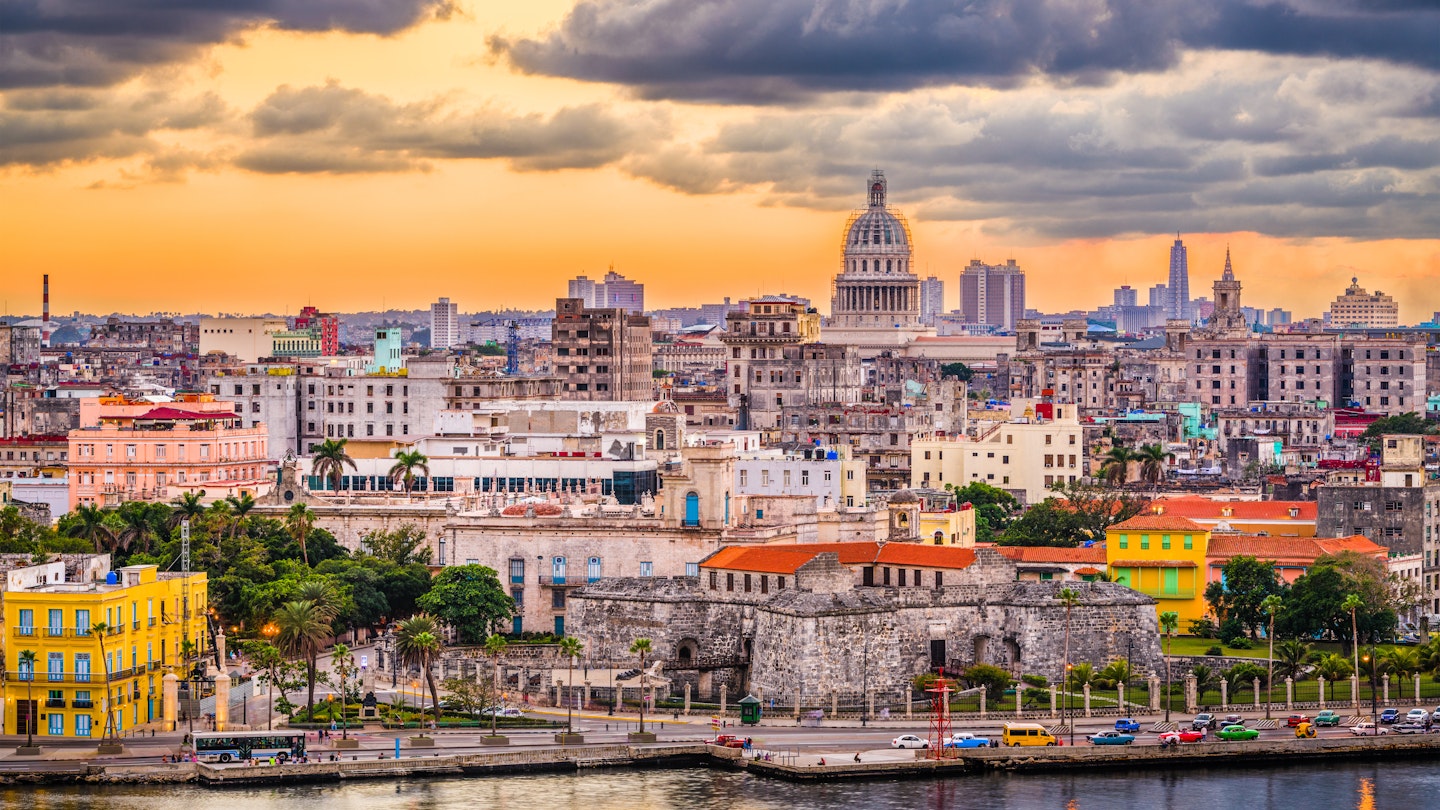
Experience the very best of Cuba with these top places to visit, starting with Havana © Sean Pavone / Shutterstock
From gorgeous cities swaying to the beat of tropical rhythms to unspoiled, lush forests, Cuba delights travelers with a wide variety of contrasting places.
Travelers will find eclectic architecture, white-sand beaches and prime wildlife-watching spots across the country. Here are 10 places worth adding to your Cuba itinerary to truly experience the Caribbean’s biggest and most fascinating island.
Best city for art and architecture
The Cuban capital of Havana is packed with vintage cars, embellished with old-world cobblestone plazas and silhouetted on the north by a 5-mile sea drive known as the Malecón.
Make sure you visit Habana Vieja ’s old squares for a glimpse of the colonial architecture that shaped the city in the 1700s and 1800s, where you can admire the palatial mansions that now operate as museums and hotels.
A walk along pedestrianized Calle Obispo offers art galleries, shops, music venues and incredible architecture, with buildings spanning periods from the 1700s to the late 1900s in just a mile.
Planning tip: Art is everywhere in Havana, with plenty of galleries and artsy outdoor areas such as San Isidro Art District and Fusterlandia . For an in-depth session on Cuba’s artistic history, spend a day at the Museo Nacional de Bellas Artes – Arte Cubano .
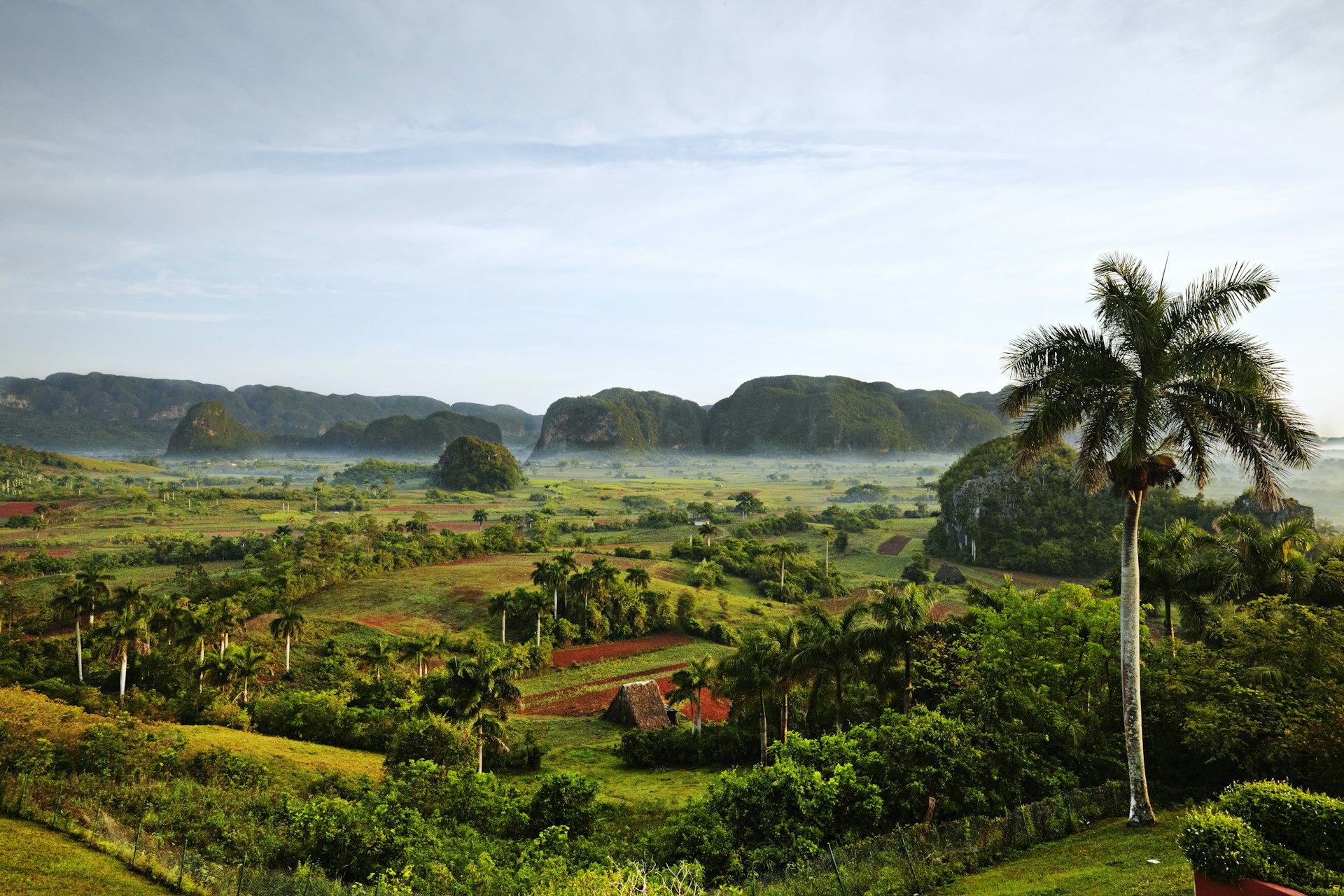
2. Valle de Viñales
Best for tobacco plantations
About 180km (100 miles) west of Havana, Viñales is one of the most beautiful places in Cuba. It was added to UNESCO's World Heritage List because of its dramatic landscapes of red soils and distinctive limestone outcrops called mogotes.
Viñales has the best casas particulares (private homestays) in Cuba and some of the friendliest and most helpful casa owners, who are the go-to coordinators for local activities. Choose from cycling, horseback riding or hiking to Los Acuáticos and Valle del Palmarito, or drive to the Gran Caverna Santo Tomás , Cuba’s largest cave system.
Planning tip: Touted as the growing spot of the world’s best tobacco, Viñales isn’t fully experienced unless you book an expert-guided tour inside the triangle-roofed drying houses scattered on local tobacco plantations.
3. Varadero
Best Cuban beach resort
Even if every tourist in Cuba decided to meet in Varadero , there’s still room for more. Varadero is Cuba’s best beach resort, with 20km (12 miles) of white, powdery sand and impossibly crystalline waters.
You can stay in all types of accommodations, from top-end all-inclusive resorts to beautiful casas particulares . Families enjoy Varadero’s safe, shallow shores while revelers dance the night away at Casa de la Música or themed party nights at hotels.
Planning tip: When you tire of the beach (if that is possible), while away an afternoon sipping rum-infused cocktails at Mansión Xanadú ’s rooftop bar while gazing out at the peninsula.
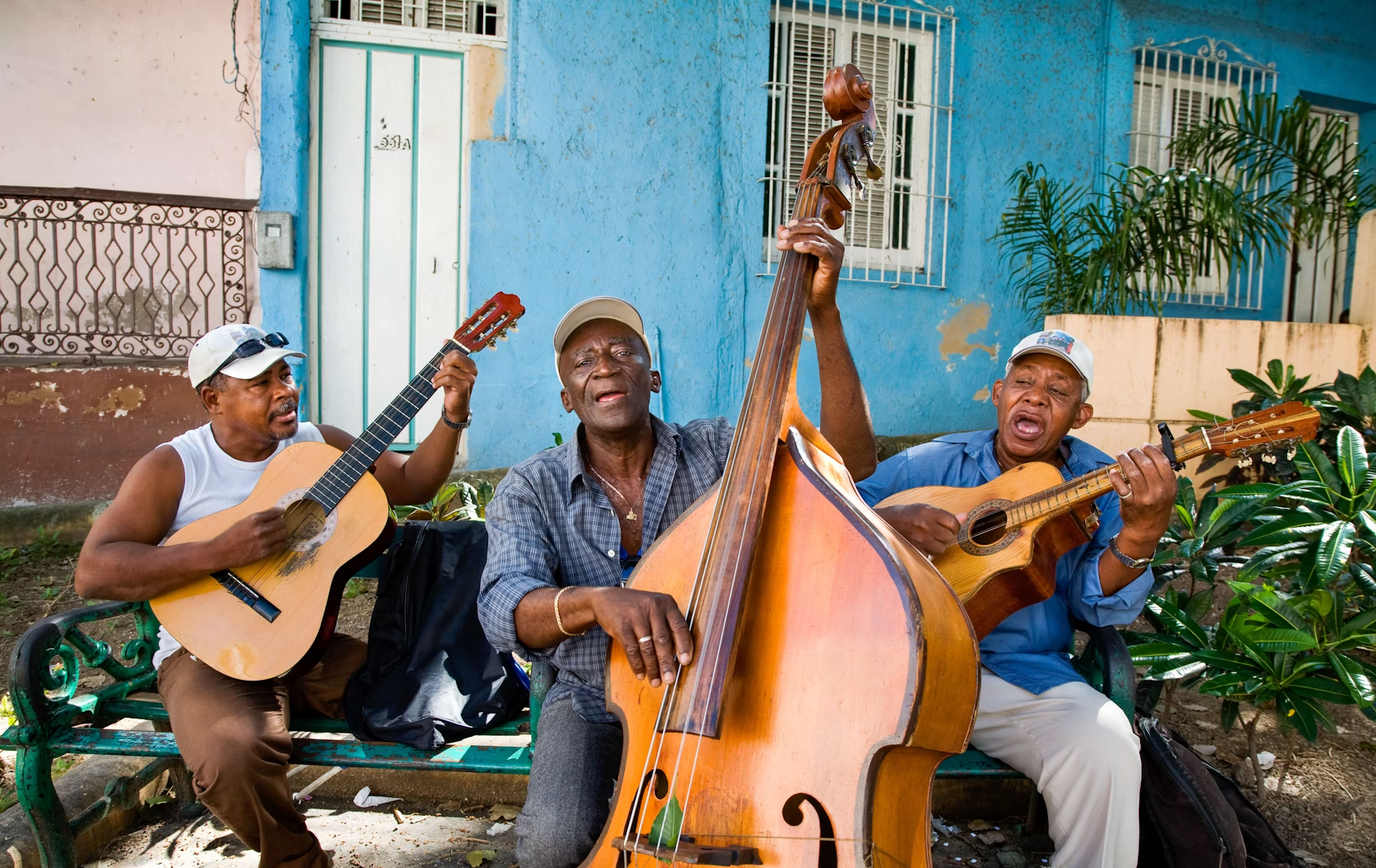
4. Santiago de Cuba
Best for understanding Cuba’s revolutionary history
Considered the second capital of Cuba, Santiago de Cuba was the HQ of the revolutionary guerrillas in the 1950s, but there’s more to experience here. Caribbean rhythms, tropical flavors and frenzied festivals set the rhythm of this colorful city.
Start with a visit to Cuartel Moncada , one of Cuba’s best museums, with a curated collection of the guerrillas’ paraphernalia and a detailed explanation of the events that started the 1959 revolution. Continue your journey through the past at the Basílica de Nuestra Señora del Cobre , Cuba’s most venerated church.
It has an exhibition of offerings given to the patron saint, including those given by the bearded revolutionaries themselves in the 1950s.
Planning tip: In symphony with its rebellious roots, Santiago bursts with a constant party-like atmosphere, reaching its pinnacle at the nationally famous Carnavales (Carnival) right after the Día de la Rebeldía Nacional (National Rebellion Day) on July 26.
Best for wildlife spotting
Located in the easternmost tip of Cuba, just getting to Baracoa is an experience in and of itself. The road from Guantánamo leads to La Farola, a sinuous 60km-long (37-mile) road considered the most scenic drive in Cuba.
Expect a three-hour trip through lush mountains, interrupted only by vendors of cucuruchos de Baracoa , a cone-shaped mix of coconut flakes, honey, guava paste and a fruity flavor (such as pineapple and orange rinds) all wrapped up in a palm frond.
Planning tip: Río Duaba and El Yunque are great spots for hiking among abundant flora and birdlife, but if you’re looking for a deeper immersion into semi-virgin forests, book a tour at Parque Nacional Alejandro de Humboldt.
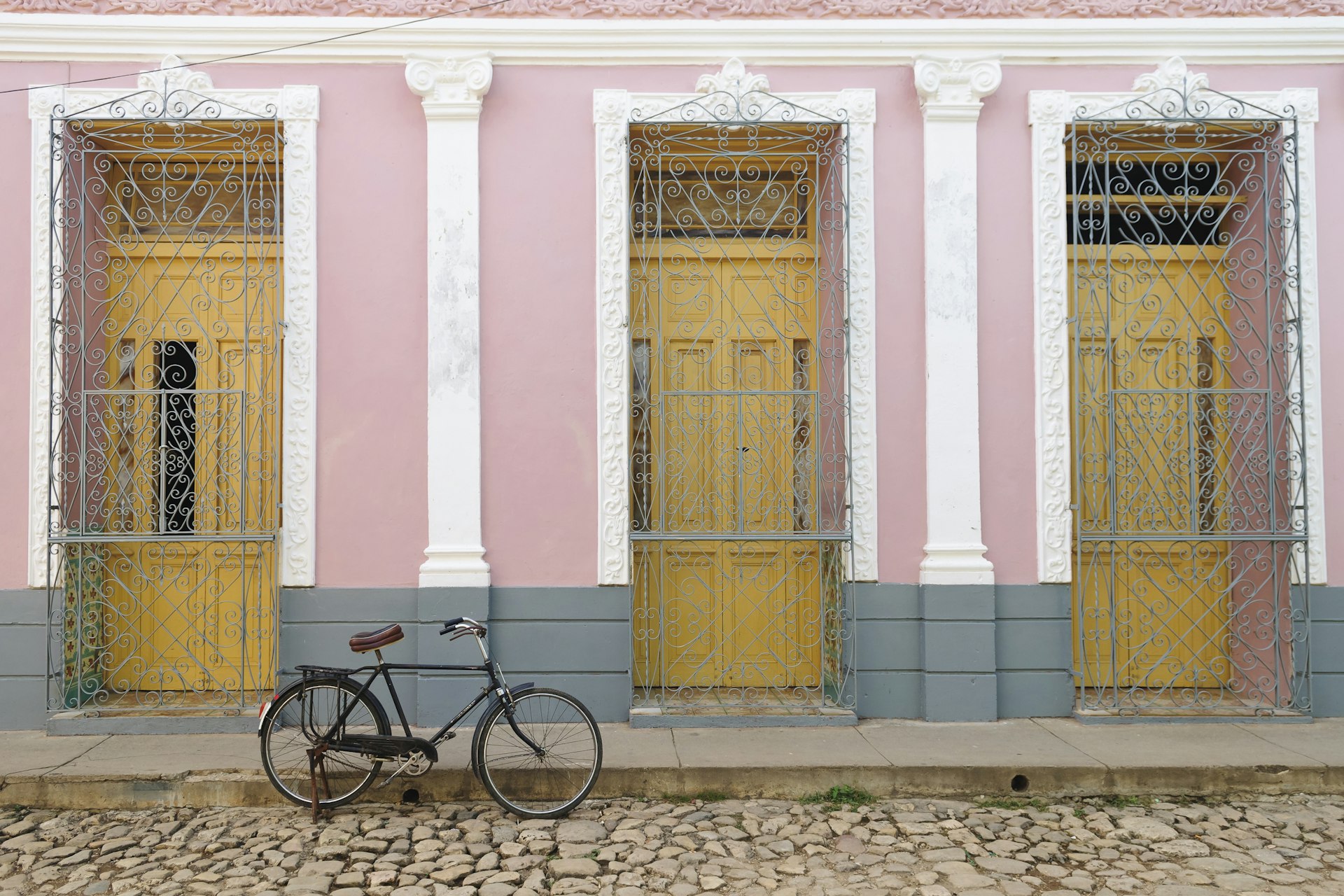
6. Trinidad
Best for shopping handmade arts and crafts
Declared a UNESCO World Heritage Site in 1988 and a World Craft City in 2018, Trinidad , full of cobblestoned streets and colonial-era mansions, is not only Cuba’s best-preserved “open-air museum,” it’s also a cradle of the best handmade crafts on the island.
Trinidad's needleworkers stitch their linen pieces at open-air markets, exhibiting handmade clothing, delicate embroidered tablecloths and garments such as guayaberas (Yucatán shirts).
Planning tip: You’re likely to see local markets on pedestrianized parts of the town’s historical center, adjacent to the Plaza Mayor , but artisans also display a daily fair at the base of Torre Manaca Iznaga , 16km (10 miles) outside of Trinidad.
7. Matanzas
Best for live music and dancing
Touted as the Athens of Cuba, Matanzas is the homeland of some of the country’s most cherished performers, such as Miguel Failde, creator of the cheek-to-cheek danzón (ballroom dance).
The city is also the birthplace of rumba, an Afro-Cuban dance that 70-year-old music group Muñequitos de Matanzas has promoted worldwide. Look out for live music performances held weekly at the Museo Histórico Provincial – Palacio de Junco .
Local tip: For travelers looking for a more Cuban Cuba – and not the usual tourist postcard of Varadero – Matanzas offers alluring architecture, featuring neoclassical buildings such as the fully restored Teatro Sauto or living antiques like the Museo Farmacéutico , founded as the first of its type in Latin America in 1882.

8. Cienfuegos
Best spot for water sports including kayaking, fishing and windsurfing
Known as the Pearl of the South, Cienfuegos is Cuba’s French-inspired city, founded in 1819 on a beautiful natural bay. Deep enough to welcome cruises and mega-yachts, the bay is best enjoyed from Punta Gorda and the nautical centers at Club Cienfuegos and Marlin Marina Cienfuegos.
Planning tip: Enjoy a day kayaking, fishing or windsurfing, but make sure you include an excursion to Laguna Guanaroca , Cienfuegos’ natural protected area, for the chance to see flamingoes and take a boat trip on the lake.
9. Camagüey
Best city for strolling maze-like alleys
Elegant and artistic, Camagüey oozes charm and youthful energy, but it’s the surprisingly intricate street pattern of the city center that usually strikes visitors most.
With most of the grid formed by one-way narrow streets, it’s almost impossible to figure it out if you’re behind the wheel. Instead, stroll around maze-like alleys to discover small but lovely plazas all within walking distance from one another.
Spend a day wandering between the artisan market in Plaza San Juan de Dios and the less-visited Plaza del Carmen , home of the inspiring art gallery of Martha Jiménez Pérez .
Planning tip: Check out Cuba’s narrowest and shortest streets while you're in Camagüey. Callejón del Cura is only 1.4m (4.6ft) wide, while Callejón de la Miseria is 15m (49ft) wide, with only two houses facing each other.
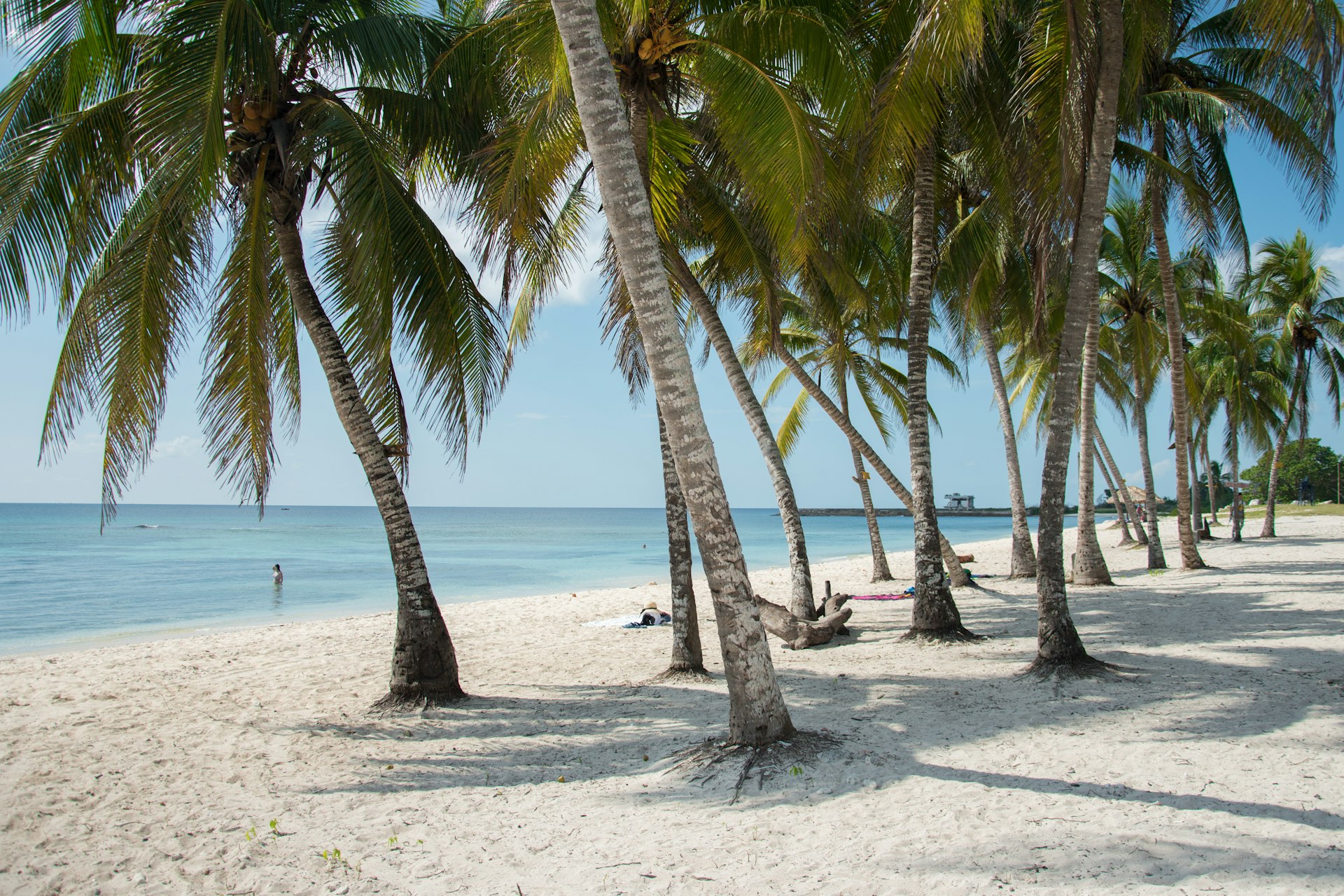
10. Playa Girón
Best for swimming, diving and birdwatching
South of Matanzas province, Playa Girón has one of the country’s best diving sites that isn’t far offshore – no boat required! The clear Caribbean waters offer impressive visibility and a colorful variety of marine fauna. Go for a refreshing swim in a gorgeous cove at Caleta Buena , or look for coral reefs at Punta Perdiz .
Playa Girón is also one of the best places in Cuba for birdwatching because it is part of the Parque Nacional Ciénaga de Zapata, which welcomes about two-thirds of the nearly 350 bird species that call Cuba home.
Planning tip: On the way from Playa Larga to Playa Girón, make sure you stop at Cueva de Los Peces , one of Cuba’s few cenotes.
This article was first published Dec 8, 2021 and updated Jan 9, 2024.
Explore related stories
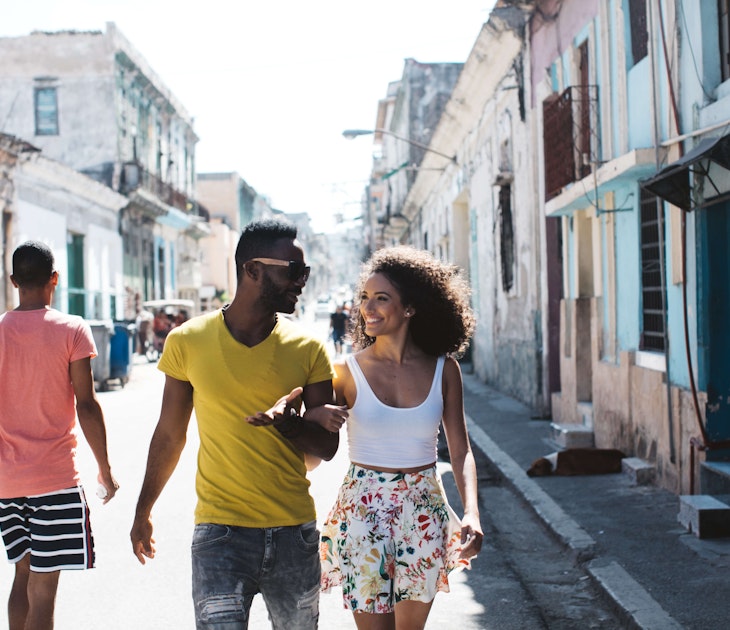
Tips & Advice
Jan 18, 2024 • 4 min read
Travelers often have questions about the visa process for Cuba and whether US citizens can even visit. Here’s our guide to Cuba’s visa requirements.
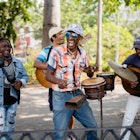
Jan 9, 2024 • 4 min read

Jan 7, 2024 • 10 min read
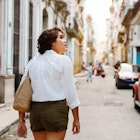
Jan 6, 2024 • 7 min read

Jan 5, 2024 • 8 min read
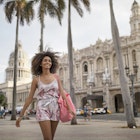
Jan 5, 2024 • 4 min read
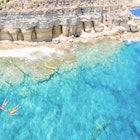
Nov 24, 2023 • 7 min read

May 6, 2023 • 9 min read

Jan 6, 2023 • 7 min read

Jan 5, 2023 • 8 min read

Prime Minister optimistic about tourism recovery in Cuba
- May 2, 2024
Speaking at the opening of the 42nd International Tourism Fair of Cuba (FITCuba 2024), he congratulated local and foreign ministers and professionals of the sector who are faithful to the development of this insular sector.
He referred to the opinions and participation in the event, and said that FITCuba can already be considered a success.
In particular, he thanked the presence of the presidents of the Spanish hotel chains Meliá and Iberostar, Gabriel Escarrer and Miguel Fluxá, respectively.
As encouraging news, he commented that Cuba won an irrevocable lawsuit in Mallorca, Spain, filed against Meliá, Gaviota and the Cuban government.
He said that this country is facing a war economy, in an intensified blockade by the United States against it, and gave three recent examples in this regard.
He pointed out that the island is the only country to which U.S. citizens (main visitors to the Caribbean) are forbidden by law to travel, and as an application of extraterritoriality, 300,000 electronic visas were canceled for Europeans to enter the US due to visiting Cuba before.
The third example was that the Argentine company that supplied fuel to Cubana de Aviación planes in that country was banned from continuing its work, all this -he insisted-amid a subversive and divisive policy of Washington to overthrow the Cuban Revolution.
He mentioned that the delegations present will have firstly the possibility of outlining new strategies and business, in addition to familiarizing themselves with the destination, its history, culture, and traditions.
He talked about the Cuban government’s main projections for 2024, many of which are related to tourism.
Among them are: to make progress in macroeconomic stabilization, increase and diversify foreign income, encourage domestic production in foreign investment, integrate all the country’s economic factors, making progress in the strategic management of territorial development and community tourism.
He ratified before the delegates, the purpose of Cuba to strengthen its tourism and continue resisting, in search of development, for which, 4 million of its inhabitants, despite the complex situations, marched this first of May in all the rallies held throughout the country, he concluded.
jrr/abo/ro/tdd/rfc
- # CUBAN # optimistic # tourism
Angola’s International Tourism Exchange seeks to promote sector
Bolivia’s international reserves soar in 1q 2024, cuba demands palestinian membership to un, colombian avianca airline announces flights to havana in july.
| Text SMS to 8100 with content PL Receive 4 mesages x 25 cup
© 2016-2021 Prensa Latina Latin American News Agency
Radio – Publications – Videos – News by the minute. All Rigts Reserved.
St. E No 454 , Vedado, Habana, Cuba. Phones: (+53) 7 838 3496, (+53) 7 838 3497, (+53) 7 838 3498, (+53) 7 838 3499 Prensa Latina © 2021 .
Web Site developed by IT Division Prensa Latina.

- Español
- Français
- Português

HAVANA, MAY 2, 2024
OFFICIAL VOICE OF THE COMMUNIST PARTY OF CUBA CENTRAL COMMITTEE
42nd international tourism fair, cuba's tourism values within the reach of the world.
FitCuba 2024, the most important professional event in the Cuban tourism sector, will be held until May 5
Author: Susana Antón | [email protected]
may 2, 2024 09:05:02

The 42nd International Tourism Fair, FitCuba 2024, started on May 1st in Jardines del Rey, dedicated to Latin America and the Caribbean; an area that, in the words of Gustavo Santos, regional director of UN Tourism, could be a major multi-destination zone. In statements to the press, the official stressed that this is a market of 500,000,000 people in which connectivity must continue to be stimulated, an aspect on which Cuba is working, and which will be reflected both in the number of visitors arriving on the island and in the country's development. He stressed that, with its participation in FitCuba 2024, UN Tourism shows its support to this event, considered the most important professional event of the Cuban tourism industry. Santos stressed also that tourism is a fundamental tool for the economic growth of countries, in compliance with the 2030 Agenda; first, because it represents an activity whose resources are natural and/or cultural, as a factor of sustainability and preservation. Second, because it is one of the productive activities that is most supported by the strategic objectives of the United Nations. He added that the organization he represents promotes accessible tourism and works to prepare the infrastructure and services "not only as a moral fact, but also as an economic fact". FitCuba 2024 will present a wide range of business opportunities in Cuba and the potential of the sector to tour operators, travel agencies, hoteliers, suppliers and related professionals.

Recommended
Central report to the eighth congress of the communist party of cuba.

Why we don’t need more than one party

Our Communist Party is unique

From Martí to Fidel: A party to unite

Continuity takes root in Party cadres

One party, Fidel’s

The First Congress of the Communist Party of Cuba

Three keys to Fidel’s party

A present based on memory
Press directory:, publications online.
Juventud Rebelde | Trabajadores. | Cubadebate | AIN | Prensa Latina | Opciones | CubaSi | Cubahora | Cubaperiodistas
Bohemia | Cuba Socialista | Mujeres | Tricontinental | La Jiribilla | Alma Mater | Caimán Barbudo | Juventud Técnica | Pionero
TV Cubana | Radio Cubana | Radio Habana Cuba | Radio Progreso | Radio Rebelde | Radio Reloj | Radio Taino | Radio Musical Nacional
Partido Comunista de Cuba | Sitio oficial del Gobierno de la República de Cuba | Ministerio de Relaciones Exteriores | Aduana

GRANMA © 2014 | Founded October, 3, 1965 | ISNN 0864-0424 | General Suárez & Territorial, Plaza de la Revolución, La Habana. Cuba | Telephone: 881-3333
Cuba Travel
Cuba Travel is the official tourism website in Cuba. It delivers the most complete and updated information on Cuba’s tourist poles and its main assets as a tourist destination. It’s the sales channel with the largest inventory of Cuban tourist products and services that guarantees the best internet price.
Share Cuba Travel
- Entertainment
- Newsletters
Colombia becomes hub for child sex tourism, Miami agents step up efforts to combat it
In an exclusive interview with Local 10 News Thursday, Anthony Salisbury, Homeland Security Investigations Miami’s Special Agent in Charge, spoke about the ongoing initiatives aimed at preventing sexual predators from utilizing Miami as a gateway to exploit some of the world’s most vulnerable children overseas.
MORE VIDEOS
Local 10 news @ 4pm : may 02, 2024, local 10 news @ 3pm : may 02, 2024, local 10 news @ noon : may 02, 2024, local 10 news @ 9am : may 02, 2024, local 10 news @ 6am : may 02, 2024, school of salmon, trends in home design, local 10 news @ 5am : may 02, 2024, local 10 news @ 4:30am : may 02, 2024, video of trash at sea prompts volunteer to take action, local 10 news @ 11pm : may 01, 2024.

IMAGES
VIDEO
COMMENTS
Greatest Waterfalls in Cuba. Imagine finding yourself in Cuba, surrounded by an exuberant natural environment - where the vivacious green mountains stretch out into a splendid blue sky - while the fresh Caribbean seabreeze brightens your face. And on this tropical voyage, you discover a land of waterfalls on every corner of the island.
2. Fill out your passenger information in advance. Cuba uses an online form called D'Viajeros to gather traveler information, including immigration and health data, in advance of travel. Fill out the form digitally up to 72 hours before your arrival in Cuba. 3.
Cuba is an archipelago made up of the largest island of the Antilles called Cuba, Isla de la Juventud (formerly called Isle of Pines), and another 4,195 cays, islets and adjacent islands. It is located in the Caribbean Sea (or Caribbean Sea), near the coast of the United States and Mexico. Its limits are to the north with the Strait of Florida ...
To enter Cuba, all visitors need to present a completed Tourist Card — which serves a similar function to a tourist visa. These are usually available through your airline (ask when booking). Alternatively, you can purchase one through a Cuban travel agency. Costs range from US$50 to US$85, including processing fees.
Learn About the Cuban Revolution. Cuba is so much more than the Cuban Revolution! The evidence of the revolution is everywhere, certainly, but there is so much more you'll see and learn here as you meet the people, try the food, and see the art here in Cuba.. Make sure to visit these sites if you're interested in learning more about the Cuban Revolution:
If you're looking to travel to Cuba with kids, you'll find music, carnivals, watersports, horse riding, classic American car rides and much more. Read article. Best Road Trips. From beaches to mountains to historic cities and more, these road trips around Cuba offer access to the best of this enchanting island.
Cuba. U.S. citizens still need to jump through a few hoops to visit Cuba, but as visitors from around the world know, this island offers some amazing opportunities for cultural exchange. Havana is a mix of old-world architecture and of-the-moment culture. Head out of the capital city to the small town of Trinidad to see more Spanish colonial ...
Call us in Washington, D.C. at 1-888-407-4747 (toll-free in the United States and Canada) or 1-202-501-4444 (from all other countries) from 8:00 a.m. to 8:00 p.m., Eastern Standard Time, Monday through Friday (except U.S. federal holidays). See the State Department's travel website for the Worldwide Caution and Travel Advisories.
Your ultimate Cuba travel guide, with tips, things to do, and best things to see in Cuba. Great for first-time and returning travelers. Located on the largest island of the Caribbean, Cuba is a very popular tourist destination and for good reason. Cuba is home to beautiful white-sand beaches, impressive rainforests and waterfalls, vibrant ...
Regardless of the license under which you travel to Cuba, you'll still need to organize a few important documents before you go. The Cuban government requires that all travelers entering the country provide a valid passport and proof of travel insurance that covers medical emergencies and evacuation by air. In addition, all U.S. travelers—adults, children, and infants—must purchase a ...
Tourism in Cuba is an industry that generates over 4.7 million arrivals as of 2018, and is one of the main sources of revenue for the island. With its ... Tourism travel to Cuba was soon declared by the U.S. State Department to be contrary to U.S. foreign policy and against the national interest.
Hola Cuba. Lauren · Traveled March 2024. Wonderful and immersive introduction into Cuban culture in an off the beaten path adventure. Our guide, Adita, is an absolute gem - knowledgable, empathetic, flexible, kind and full of energy and enthusiasm to introduce visitors to her country. We had a wonderful time, learned a lot and gained memories ...
Boca de Guama is the peninsula's tourist center, and its main attraction is the Criadero de Cocodrilos, a crocodile farm. 14. El Nicho Waterfalls. Poceta de Cristal in El Nicho National Park. If you're looking for a ravishing slice of nature in central Cuba, head to El Nicho waterfalls.
Customs Regulations for Entrance and Exit: The National Customs of the Republic of Cuba constitutes a control organ of the border and the control in the activity linked to foreign trade. It has the mission of direct in custom matters, collect customs duties and give response inside its jurisdiction and compete to the facts that affect the ...
7 min. Americans who want to travel legally to Cuba will have more options after the Biden administration announced it was undoing some of the restrictions President Donald Trump imposed before ...
Find in Cuba Travel, Official Tourism Website of Cuba, everything about the Cuban and Cuban identity. This website uses cookies to ensure you get the best experience on our website. Learn more. Got it!
The pandemic combined with a recently tightened US embargo has hit the already weakened economy particularly hard. Tourism accounts for over 10% of Cuba's GDP and Canadians make up nearly one-third of all tourists. We were enthusiastically welcomed with smiles, music, dance, and rum cocktails.
About Havana . Life in La Havana passes by surrounded by music, tradition, culture, national monuments and natural attractions of immeasurable value. Dances and Cuban "sones" spread to each one to this land's children and to those who visit it as well; customs and traditions remain untouched and join new national and international celebrations to amaze visitors that plan a visit to La ...
Travel Advisory. January 5, 2024. Cuba - Level 2: Exercise Increased Caution. C. Reissued with updates to crime information. Exercise increased caution in Cuba due to crime. Country Summary: Petty crime is a threat for tourists in Cuba. Also, violent crime, including armed robbery and homicide, sometimes occurs in Cuba.
Boasting a bounty of beautiful beaches, along with extraordinary wildlife-watching experiences, adventure opportunities and festivals, Cuba has much to commend it whenever you visit. That said, the best month to visit Cuba depends on what you most want to do, and your budget, along with your opinion on the likes of tourist numbers, and the potential risks of the hurricane season.
HAVANA, Cuba — Cuba is hoping more tourists return to the island, after a lengthy shutdown during the COVID-19 pandemic. Tourism is vital to the communist country's economy, which has taken a ...
Drugs, alcohol and travel. Child sex tourism. It's a serious criminal offence to have sex with minors in Cuba. Local authorities are actively working to prevent child sex tourism. Tourists, including Canadians, have been convicted of offences related to the corruption of minors aged 16 and under.
Despite the economic crisis in Cuba, the island saw an exceptional number of tourists in 2023. According to government reports, visitor numbers have reached a peak not seen since the COVID-19 ...
4. Santiago de Cuba. Best for understanding Cuba's revolutionary history. Considered the second capital of Cuba, Santiago de Cuba was the HQ of the revolutionary guerrillas in the 1950s, but there's more to experience here. Caribbean rhythms, tropical flavors and frenzied festivals set the rhythm of this colorful city.
Jardines del Rey, Cuba, May 2 (Prensa Latina) Cuban Prime Minister Manuel Marrero today expressed optimism about the recovery of tourism in this country. ... are forbidden by law to travel, and as ...
Photo: Cubadebate The 42nd International Tourism Fair, FitCuba 2024, started on May 1st in Jardines del Rey, dedicated to Latin America and the Caribbean; an area that, in the words of Gustavo Santos, regional director of UN Tourism, could be a major multi-destination zone.
Cuba Travel is the official tourism website in Cuba. It delivers the most complete and updated information on Cuba's tourist poles and its main assets as a tourist destination. It's the sales channel with the largest inventory of Cuban tourist products and services that guarantees the best internet price. Cuba Travel tiene la mejor guía ...
This meeting will take place in Varadero, as a preliminary step to the holding of the 42 nd International Tourism Fair (FITCuba 2024) scheduled for May 1 to 5 in Jardines del Rey. UN Tourism, formerly known as the World Tourism Organization (UNWTO), is an international organization whose purpose is promoting this sector.
While sustainable tourism aims to minimize its impact on ecosystems, regenerative tourism goes a step further by approaching nature with a purpose to repair. Sustainable tourism is about respecting the environment, whereas regenerative tourism involves ecological justice. Both share traits like awareness of the climate crisis and a commitment to caring for the planet and all its inhabitants.
If you need help with the Public File, call (954) 364-2526.